PinotFile: 8.32 March 1, 2011
|
Embarrassment of Riches in PinotlandPinot Noir is now produced by more American wineries than any other red variety. Today, it is the wine winemakers want to make and the wine consumers want to drink. We have fallen head over heels in love with Pinot Noir. It was not that long ago, about twenty-five years, that consistency was the Achilles heal of American Pinot Noir. There was plenty of lackluster Pinot Noir in the marketplace, sourced in many cases from vineyards planted in the wrong location and farmed all wrong for this finicky grape. I personally spent a small fortune on disappointing Pinot Noir throughout those formative years. It is interesting to read an article by James Laube in the Wine Spectator from 1993 on Pinot Noir titled, “American Pinot Noir: A Work in Progress.” It was the consensus of the time that there were few good Pinot Noir winemakers and many wineries were too poor to afford the best equipment. Winemakers were learning on the job and still discovering appropriate vineyard management and winemaking techniques. They were plagued by flaws and inconsistencies in their wines. There was no discounting their dedication, however, and that commitment has paid off in quantum leaps in quality and consistency. Today, we have an embarrassment of riches in American Pinot Noir. We are blessed with a cadre of bright, talented growers and winemakers, and a diverse array of remarkably pleasurable Pinot Noirs from all reaches of California and Oregon. There is no longer a need to bring up the hackneyed goal attached to Pinot Noir in years past that consistency is the Holy Grail of Pinot Noir. The leap in quality of American Pinot Noir now challenges the wine critic to be more critical, more vigilant, more fine tuned to small differences in quality. Clearly, ratings are gradually rising, with more Pinot Noirs receiving higher scores. As an example, in the Wine Spectator’s January 31-February 28, 2011 issue on Oregon’s 2008 vintage of Pinot Noir, 60% of the 510 judged wines from that vintage had outstanding scores (90 to 94). This is an astonishing number when you think about it. There are more Pinot Noirs receiving my highest accolades as well as indicated by the large number of wines in this issue awarded the Pinot Geek title (93-95 equivalent) or Very Good accolade (90-92 equivalent). Its a great time to have a love affair with Pinot Noir. There is something for everyone, with many good wines priced under $30, and many high-collared more expensive wines, delivering an indulgent and seductive drinking experience. Whether your tastes veer to lighter-bodied, elegant Pinot Noir with lower alcohols (Mini- Coopers), medium-bodied, moderate alcohol, harmonious wines (Corvettes), or big-bodied, riper, lush-flavored Pinot Noir (Hummers), you will find something to please you. The words of Steve Pitcher in The Wine News from 2002 ring out even more true today, “Of all the accomplishments in American winemaking and viticulture in the last quarter of the 20th century, none as been as impressive as the dramatic evolution of Pinot Noir from near-dismal failure to celebrated success poised at the threshold of greatness.” I believe that since he made this remark nearly nine years ago, we can proudly say American Pinot Noir has reached that threshold. If you aren’t buying American Pinot Noir from accomplished producers such as the ones featured in this issue, you haven’t sampled them lately.
Thomas George Estates: On the UpswingWhen I last made a significant mention of Thomas George Estates in the PinotFile in 2008, the iconic Davis Bynum Winery on Westside Road had been sold to the Baker family of Toronto, Canada. I visited President Jeremy Baker back then at a time the winery was undergoing a much-needed complete renovation. The exterior and interior of the old winery, which had been a hops processing room next to a former kiln, was being transformed into a modern winemaking facility with the latest winemaking equipment. The winery was expanded to allow eventual production of 16,000 cases annually, and the tasting room was upgraded, retaining its original location, but outfitted with a modern flair. In 2010, caves (singularly unique to Westside Road) were built into the adjacent hillside to function as a barrel aging facility as well as an additional tasting and entertaining area that would appeal to wine romanticists. New landscaping was added to create an attractive outdoor picnic area. When I visited recently, I was amazed at the transformation. The winery had become a destination, a sterling, hi-collared addition to the Middle Reach array of prominent Russian River Valley Pinot Noir producers with an appeal to wine aficionados of all ages.
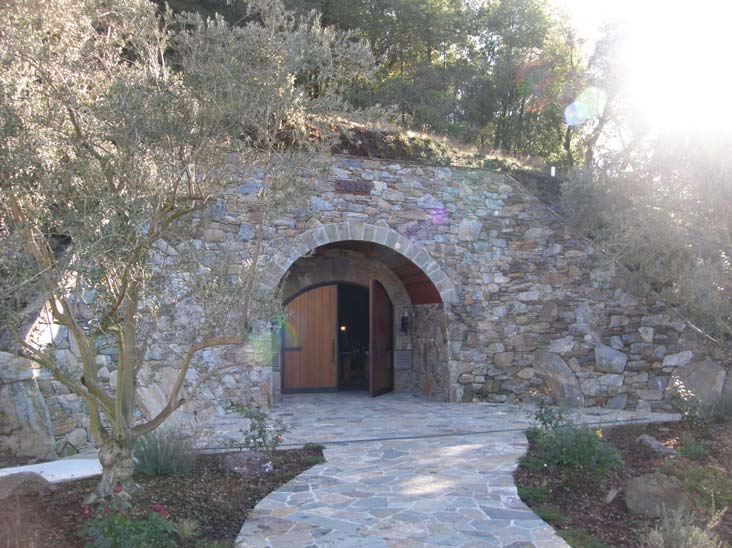 The wines of Thomas George Estates have been infused with a new spirit and quality as well. The estate Baker Ridge Vineyard (formerly Lindley’s Knoll), which sits in a prime Middle Reach location adjacent the Williams Selyem Estate Vineyard and Arista estate vineyards, was revitalized and partially replanted under the direction of noted viticulturist Ulises Valdez. The Baker Ranch Vineyard now consists of 21 acres of Pinot Noir, 4 acres of Chardonnay and small amounts of Grenache and Viognier. The winery acquired the 26-acre Starr Ridge Vineyard on Windsor Road and the 14-acre Cresta Ridge Vineyard in the Green Valley appellation, both premium sources of Pinot Noir and Chardonnay. The new winemaker, Chris Rossi, is a University of California at Davis graduate who left an eight-year stint as winemaker at Christopher Creek to join Thomas George Estates. Like Jeremy Baker, Rossi is young and enthusiastic and has instituted modern winemaking techniques, beginning with the 2008 vintage. The 2007 Thomas George Estates wines were made by a different winemaker and included a number of non-estate grape sources. After the winery officially opened in January 2009, these wines were offered and I received a number of disappointing reports about the wines from visitors. The 2008 vintage wines now available were the first produced in the new winemaking facility under the direction of Rossi are impressive and are a world apart in quality. Beginning with the 2009 vintage, essentially all Pinot Noir and Chardonnay was estate grown. The crew at Thomas George Estates is pictured below (L to R, Chris Rossi, Jeremy Baker, Operations manager Sean Tevik, and one of three winery dogs, Muki).
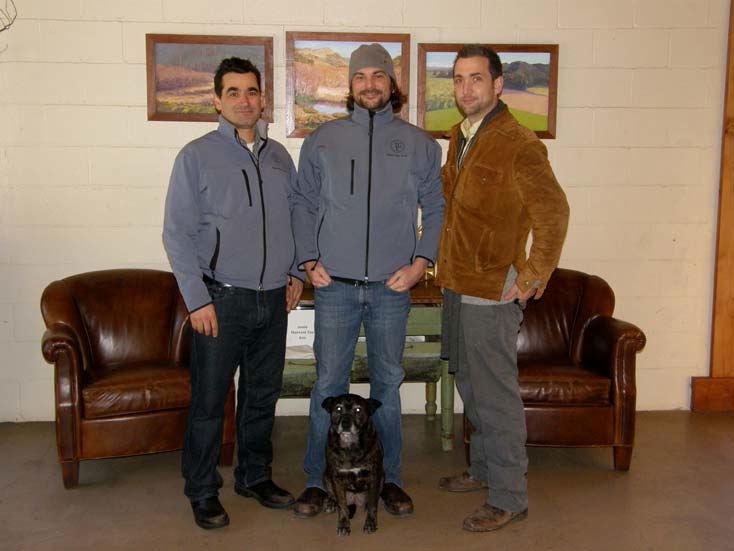 In January 2011 I tasted several 2008 Pinot Noirs out of bottle as well as a 2009 Russian River Valley bottling and a 2009 sparkling wine. I re-tasted several wines at home a month later. The 2008 and 2009 vintages will be the last for Sonoma Coast Pinot Noir as the winery concentrates solely on Russian River Valley vineyards. Rossi de-stems the grapes and uses a basket press for gentle pressing. New oak is kept to a minimum: no wine receives more than 40% and I found that none of the wines showed a heavy-handed oak influence (which I prefer). The ultimate goal of the winery is to feature primarily Pinot Noir (50% of bottlings as vineyard designated and 50% in the Russian River Valley blend) and Chardonnay, with a few other limited varietal bottlings and sparkling wine for fun.
2009 Thomas George Estates Saralee’s Vineyard Russian River Valley Pinot Blanc 14.0% alc., pH 3.20, 190 cases, $27. Whole cluster pressed to tank, fermented and aged in stainless steel with no malolactic conversion. · Straw color in the glass. Attractive aromas of white peaches, exotic flowers and green apples. Pleasingly dry and crisp with flavors of peaches, pears, honey and roasted nuts. A pleasant change from Chardonnay. Serve slightly chilled as a refreshing aperitif. Good.
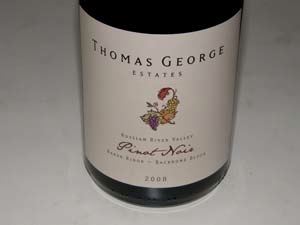 2009 Thomas George Estates Russian River Valley Pinot Noir 14.3% alc., 1,280 cases, $38. To be released March 1, 2011. 100% estate fruit, clones 777, Pommard, 114, and 115. Aged 11 months in 31% new French oak barrels. · A nose to die for featuring bright aromas of black cherries, raspberries and Asian 5-spice. Delicious black cherry bombast with a hint of clove and earthiness. The hedonistic flavors are intense and persistent, and enrobed gently in fine-grain tannins. Plenty to like in this medium-framed wine that is très Russian River. This wine is a definite step up from the 2008 vintage bottling.
2009 Thomas George Estates Sparkling Brut Rosé Russian River Valley Pinot Noir 12.5%, 90 cases, $50. 100% Dijon clone 115 from Starr Ridge Vineyard picked at 19.5º brix the first part of August. · This inaugural sparkling wine release is one of only a handful of sparklers made by Russian River wineries. The pink salmon robe is attractive, the fine bead is welcoming, and the strawberry, citrus and candied cherry flavors are alluring. The wine is crisp and clean with an uplifting and refreshing finish that draws one back to the glass. Will work beautifully both as a celebratory event wine and a fashionable table wine. Very good.
2008 Thomas George Estates Russian River Valley Pinot Noir 14.7% alc., pH 3.64, 719 cases, $38. 55% clone 115, 32% 459, 13% 828 from Bush Family Vineyard and Windsor Oaks Vineyard. Aged in 38% new French oak barrels. · Nicely composed aromas and flavors of spiced cherries and berries, and cola and with gossamer tannins. A solid, very drinkable wine. Good.
2008 Thomas George Estates Campbell Ranch Vineyard Sonoma Coast Pinot Noir 14.3% alc., pH 3.50, 336 cases, $48. The Campbell Ranch Vineyard is located near the town of Annapolis in the true Sonoma Coast. Clone 777. Aged 18 months in 33% new French oak barrels. · The aromas and flavors are more savory than fruity with a hint of tar evident. Well-endowed with plenty of tannic backbone. Needs time to open. Decent.
2008 Thomas George Estates Baker Ridge Vineyard Russian River Valley Pinot Noir 14.4% alc., 186 cases, $55. A blend of all blocks in the vineyard including 55% Dijon, 25% Swan, 15% Pommard and 5% Wädenswil clones. Aged in 37% new French oak barrels. · Moderately deep reddish-purple color in the glass. Scent of dark cherries and berries with hints of violets, wet leaf, marzipan and raisin. Rich and ripe, with fullflavored array of dark fruits including black currants with hints of cola and spice. Soft and silky in the mouth. Veers to the ripely flavored side. Good (+).
2008 Thomas George Estates Lancel Creek Vineyard Russian River Valley Pinot Noir 14.6% alc., pH 3.59, 478 cases, $55. This vineyard is farmed by Ulises Valdez. 48% Pommard and 52% 777. Aged in 39% new French oak barrels. · Brooding aromas of plum sauce, cigar box and graham. The flavor in this wine strikes a chord with me. I liken it to a black cherry dark chocolate truffle without the sugar. Hearty but silky tannins support the generous dark fruits leaving a smooth impression on the palate as the finish lingers on and on. Very good (+).
 2008 Thomas George Estates Baker Ridge Vineyard Backbone Block Russian River Valley Noir 14.5% alc., pH 3.58, 60 cases, $65. Baker Ridge is located up an adjacent hill from the winery, at an altitude of 280 feet. This wine is sourced from a Martini clone block planted in 1990 by Davis and Hampton Bynum. Aged in 33% new French oak barrels. · Moderately deep reddish-purple color in the glass. The wine offers a bright array of aromas with staying power in the glass including scents of berry jam, spice and subtle oak. Charming core of perfectly ripened cherry and berry fruits with a hint of brown spice set off by bright acidity and caressed by firm but abiding tannins. Impeccable balance for the long haul. Very classy juice.
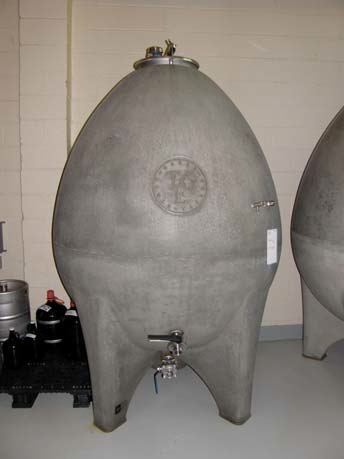 Thomas George Estates has an impressive, easily navigable website. Live views of the wine cave, winery and vineyards are offered. All wines are sold through the online store. The tasting room at 8075 Westside Road is open daily from 11:00 to 5:00. Events and picnics may be planned at the winery or vineyards and can include the “Toastermobile,” a portable kitchen offering gourmet meals at any of the winery’s picnic areas or Cave. Four ranching guest houses have been renovated and are available for rent with wine club members receiving 50% discounts for their stay. 707-431-8031. Pictured right are the new concrete wine fermentation tanks from Sonoma Cast Stone used for white wines. The tanks breathe similar to wood but do not contribute oakiness.
Kosta-Browne: Stylin’ in 2008Dan Kosta and Michael Browne are alumni of a landmark Sonoma County restaurant, John Ash & Co.. Dan Kosta grew up around wine in Sonoma. His father owned a wine store in Santa Rosa and wine was a frequent topic of discussion at the household dinner table. After joining the staff at John Ash & Co., Dan worked his way up to Head Sommelier. Michael Brown was born in the San Francisco Bay area, but grew up in Washington State. Upon returning to Santa Rosa in 1987, he enrolled in pre requisite courses at Santa Rosa Junior College to become an architect. During schooling, he worked in wine retail and at a number of restaurants but it was at John Ash & Co. where he developed a passion for wine and food and decided to become a winemaker. Dan and Michael began their winemaking venture by putting all their tip money into a “co-op” cookie jar in the kitchen of John Ash & Co.. After raising $2,600, they bought a half-ton of Pinot Noir grapes, a single barrel, and a used, hand-crank de-stemmer/crusher and produced their first vintage in 1997. That year, Michael left John Ash & Co. to become an assistant winemaker at Deerfield Ranch Winery in the Sonoma Valley, but much of his winemaking acumen was self-taught. He likes to say he learned his winemaking at “Hard Knocks University.” Dan and Michael attracted an initial investment group and in 1999 made 2,600 cases of Lake County Sauvignon Blanc. This venture proved financially unrewarding and the principals parted ways.
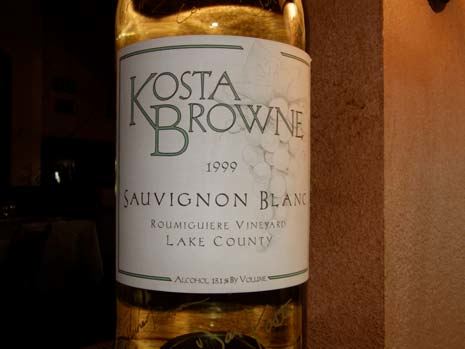 In 2001, they teamed with Chris Costello and his family in developing a fiscally conservative and thoughtful business plan. Success followed soon after. Pictured below (L to R, Dan Kosta, Chris Costello, Michael Browne).
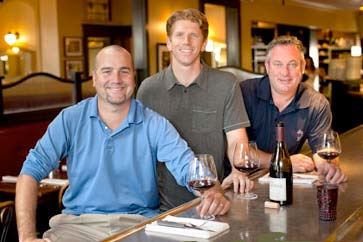 The 2003 vintage of Kosta Browne was highly regarded by wine writer James Laube of the Wine Spectator, who awarded all the 2003 Pinot Noirs scores ranging from 90 to 96. The mailing list quickly filled up, Kosta Browne appeared on every pinotphile’s radar, and the winery quickly became a member of the fraternity of prestigious Russian River Valley wine producers, many of whom had been crafting world-class Pinot Noir since the 1980s. Kosta Browne made wine in a number of facilities initially, finally settling in a large space in the former Vacu- Dry apple processing plant in Sebastopol. Twenty years ago, the Washington apple growers got together and bought the Vacu-Dry processing plant in Sebastopol, shutting it down and effectively shutting down the apple industry in Sonoma County. The plant, now owned by SonomaWest Holdings, is home to numerous wineries and artisan food producers. The Kosta-Browne leased facility is perfectly suited to the current 10,500 case production. Kosta Browne’s success stems from three sources. First, Dan and Michael are congenial and customer oriented, are well-liked in the wine community, and are willing to support many charitable fund-raising activities. Each year, magnums and larger formats are bottled, but are only donated to charitable causes and never sold to customers. This greatly increases their value and the bottlings demand very high prices (a 6L bottle was auctioned at a charity event in 2009 for $20,000). Kosta Browne also supports many wine events where they generously pour nearly their entire lineup of wines (photo below was taken at World of Pinot Noir). Second, Dan and Michael were able to use their long-standing friendships and contacts to source grapes from top growers in the Russian River Valley, Sonoma Coast and Santa Lucia Highlands appellations. Quality grapes are critical to producing fine wine. The precedent for this in the Russian River Valley was set by Williams Selyem whose success was built on acquiring fruit from top vineyards in the region. Third, Michael has given Kosta Browne Pinot Noir a distinctive stamp: a fruit-forward, hedonistic style that seduces to a broad audience of wine lovers. The wines are deep in color with moderately high alcohols, vibrant aromatics, restrained balanced tannins, silky textures, subtle oak highlights, and ripe, opulent fruit.
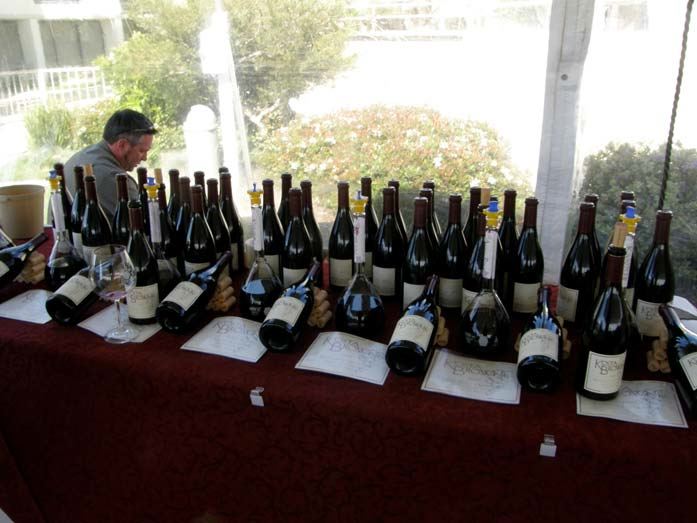 In 2009, Dan Kosta, Michael Browne and Chris Costello wanted to pay off some of the original investors and acquire a new partner. They sold a controlling interest in the winery to Vincraft for reportedly $40 million dollars. Nothing much has changed, however, with Michael Browne continuing as winemaker and Dan Kosta and Chris Costello managing the operation. I visited Kosta Browne in early 2010 and tasted the lineup of 2008 Pinot Noirs shortly after bottling (www.princeofpinot.com/article/880/). Wedged between the spectacular 2007 and 2009 vintages, the wines are nevertheless impressive and were sold out quickly when offered. I recently re-tasted the lineup of 2008 Kosta Browne Pinot Noirs. All the wines are well-crafted in the bold Kosta Browne style. Although the wines are no longer available from the winery, it is prudent to remember there will be another vintage. The song will be different but the composer will be the same. The winemaking regimen for the 2008 vintage at Kosta Browne was as follows. Grapes were de-stemmed, with some whole cluster barrels vinified separately to be added back if deemed appropriate for the vintage and the wine. An average 5-day cold soak was followed by inoculated fermentation lasting 9 to 14 days on average with 1 to 2 hand punch downs per day in 1- and 5-ton open-top stainless steel and wood vessels. The wines were barrel-aged for 16 months in French oak sourced from eight different coopers. The percentage of new French oak varied between 42% and 52% with most bottlings close to 50%.
2008 Kosta Browne Russian River Valley Pinot Noir 14.7% alc., pH 3.67, $52. Castaldi, Thorn Ridge Ranch, Graham, Pleasant Hill, Copain, Nonella, Amber Ridge, Keefer and Koplen vineyards. · A touch of confection in this wine with its aromas and flavors of black cherries, black raspberries, and a hint of smoky oak. Seductive when first opened, but loses some allure over time in the glass. A moderately rich appellation wine that won’t send pinotphiles into a tither, but very serviceable. Good.
2008 Kosta Browne Sonoma Coast Pinot Noir 14.6% alc., pH 3.66, $52. Sourced from Gap’s Crown (southern Sonoma Coast in Petaluma Gap), Terra de Promissio (southern Sonoma Coast in Petaluma Gap) and Walala (Annapolis) vineyards. · The nose is brooding initially, opening slowly to reveal darker fruit aromas that are savory and underlain with a slight ash smell. The core of ripe dark berry and plum fruits struggle to emerge from a smoky overlay. Decent.
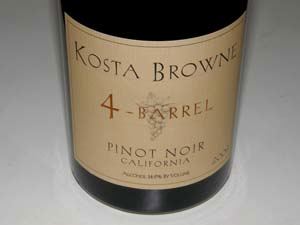 2008 Kosta Browne 4-Barrel California Pinot Noir 14.9% alc., pH 3.59, 96 cases, $72. Four barrels are identified from 70 different lots and the final four barrel blend is chosen independent of vineyard or appellation, thus the California designation. Amber Ridge Vineyard (667), Garys’ Vineyard (Pisoni), Kanzler Vineyard (667, whole cluster), and Koplen Vineyard (667, wood tank fermented). · Brooding, opening reluctantly to reveal a high-spirited array of dark red berries and cherries that push the ripeness envelope and find every nook and cranny in the mouth. Still very tight with plenty of tannin but offering textural and flavor interest from the significant whole cluster addition. Notes of cola and root beer emerge over time. Sampled two days later from a previously opened and recorked bottle, the wine was starting to display a vibrant display of fruit that literally leaped out of the glass. Don’t think about opening this connoisseur’s wine for two years. Very good (+).
2008 Kosta Browne Amber Ridge Vineyard Russian River Valley Pinot Noir 14.7% alc., pH 3.56, $72. Located in Windsor, this vineyard is planted in Goldridge and sandy clay loam soils. Clones 667, 115 and 777. · Subdued, but pleasant scent of redder cherries and berries. Soft and elegant on the palate with mild tannins and a modest charge of strawberry and cherry flavor on the finish. Lacks the pop of flavor of the other KB wines in this vintage, seemingly shallow in comparison, and deficient in finishing intensity. Good.
2008 Kosta Browne Gap’s Crown Vineyard Sonoma Coast Pinot Noir 14.8% alc., pH 3.53, $72. Inaugural single vineyard bottling for this source owned and managed by Premier Pacific Vineyards. Previously the backbone of Kosta Browne’s Sonoma Coast bottling. Clones 115, 667, 777 and Swan. · The nose opens beautifully over time revealing intense black cherry aromas with a spice cabinet background. Lovely essence of moderately intense flavors of black cherries on the palate framed by soft tannins and lifted by decent acidity. Very soft and smooth in the mouth with finishing tenacity. A fruit-driven wine that is quite tasty. Very good.
2008 Kosta Browne Garys’ Vineyard Santa Lucia Highlands Pinot Noir 14.9% alc., pH 3.57, 422 cases, $72. Exclusively Pisoni selection, 3.1 tons per acre. 18% whole cluster. · The nose explodes with a vengeance initially showing flashy dark berry and stone fruits with subtle scents of pine and mint. Tasty core of black cherry and blackberry fruit with impressive flavor intensity and persistence. The soft texture makes the wine very user-friendly. Better the next day from a previously opened and re-corked bottle. Very good.
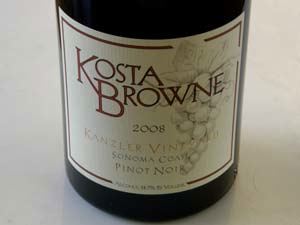 2008 Kosta Browne Kanzler Vineyard Sonoma Coast Pinot Noir 14.7% alc., pH 3.66, $72. Seventh vintage from this vineyard in Sebastopol. Clones 667, 115 and Pommard. · The wine is a little deeper purple color than the other wines from this vintage. Exotic medley of dark fruits on the nose which have a pheromone attraction. Moderately intense boysenberry and dark plum sauce flavors that are fat on the palate, leading to a finish that makes a statement. Despite its powerful fruit and substantial structure, the wine retains a smooth, even velvety, texture. Very good.
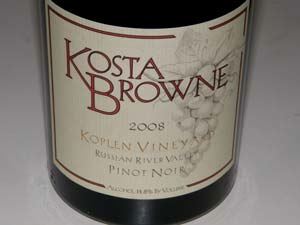 2008 Kosta Browne Keefer Ranch Vineyard Russian River Valley Pinot Noir 14.7% alc., pH 3.63, $72. Keefer Ranch is owned and managed by Marcy Keefer and her son, Craig Strehlow. Clones 23, 114, 115, 777, Pommard 5. Located in the cool Green Valley. · Along with the Rosella’s, the most feminine wine in the Kosta Browne lineup. A bit brooding but opens slowly to reveal pleasing aromas and flavors of dried black cherries, plums and a melange of fresh berries with a hint of minty oak. Discreetly concentrated with restrained tannins and a welcoming soft and smooth texture, this vintage offers a darker fruited interpretation of this vineyard. Very good.
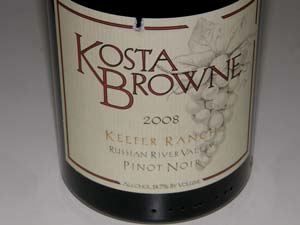 2008 Kosta Browne Koplen Vineyard Russian River Valley Pinot Noir 14.8% alc., pH 3.58, $72. All the fruit from the vineyard farmed by Dennis and Lynn Koplen goes to Kosta Browne. Dijon clone 667, 3.1 tons per acre. 18% whole cluster. · Always a wine of great interest that demands your full attention. Profusely perfumed with aromas of boysenberry jam and spice box. Full-blown hedonistic attack of dark berry and plum flavors that grab hold and persist throughout the flamboyant finish. Despite its big-boned character, the wine retains an appealing charm with a silky, almost ephemeral mouth feel. Quintessential KB.
2008 Kosta Browne Pisoni Vineyard Santa Lucia Highlands Pinot Noir 14.8% alc., pH 3.50, $72. From the 45-acre Pisoni Vineyard perched at 1,300 feet above the Salinas Valley. Pisoni clone, 2.5 tons per acre. · Similar to the Garys’ bottling but more withdrawn, only offering a glimpse of its full potential. Enticing black cherry and mixed berry aromas and flavors with a subtle overlay of spice. Exquisite and pure with a downy mouth feel that will thrill any pinotphile. A more delicate interpretation of this vineyard that needs a few years in the cellar to reach its potential. This could turn out to be a winegasm.
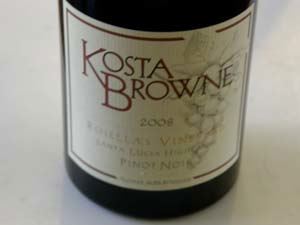 2008 Kosta Browne Rosella’s Vineyard Santa Lucia Highlands Pinot Noir 14.5% alc., pH 3.61, $72. Pisoni selection and 828 clone from a vineyard farmed by Gary Franscioni. 3.0 tons per acre. · Highly perfumed and nuanced nose featuring aromas of fresh red raspberries, cherry cobbler, baking spices and dark red rose petals. Delicious melange of dark red berries and cherries with hints of allspice and vanillin carrying through with impressive finishing intensity. Mild finegrain tannins and balanced acidity create a very charming wine that has a demure appeal. Hard to say no to.
A local wine club, Le Grand Crew, invited me recently to a dinner and horizontal tasting of 2008 Kosta Browne Pinot Noir at Mr. Stox Restaurant in Anaheim, California. Fourteen people were in attendance, most of them seasoned wine drinkers. The wines were opened, decanted and re-bottled earlier in the day. All were served at cellar temperature. The Keefer Ranch Vineyard bottling was by far the favorite of the group, with six of the fourteen in attendance voting it their favorite. The Kanzler Vineyard and Koplen Vineyard tied for second and the Garys’ and Rosella’s tied for third, with the Pisoni fourth. Kosta Browne wines, which will include a Chardonnay beginning with the 2009 vintage, are sold through a mailing list which is full at present. Visit the website (www.kostabrowne.com) to sign up for the wait list. The wines are often available on the secondary retail market and auction sites. The winery is not open to the public, but the winery participates in many major Pinot Noir festivals as well as a number of popular wine events and charitable auctions around the country (check the winery’s News page on the website for the schedule).
Siduri Wines: A Modest Winery with an Ambitious RangeAdam and Dianna Lee are accomplished self-taught winemakers who operate out of a modest warehouse in an industrial park in Santa Rosa, a no frills operation where the emphasis is on the wines. Since a quite launch in 1994 consisting all of 107 cases of Pinot Noir, the Lees have found an ambitious and changing number of excellent vineyard sources for Pinot Noir stretching all the way from Oregon’s Chehalem Mountains in the northern Willamette Valley to the Santa Rita Hills in California’s southern Central Coast. Their winery holds the distinction of producing more unique Pinot Noir bottlings than any other boutique winery in California. Adding to their impressive Pinot Noir offerings, the Lees also produce Syrah, Chardonnay and other varietals under the Novy Family Wines label, named after Dianna’s family, the Novys. Siduri’s rise to success has been meteoric with critics fawning over the winery’s Pinot Noirs since the first release. Robert Parker, Jr., has called Siduri, “One of California’s top Pinot Noir producers,” and Matt Kramer has said, “To taste Siduri is to taste some of the best Pinot Noirs made in American today.” Siduri has always been committed to quality. Grapes are purchased by the acre and crops are rigorously thinned. All work in the winery is hands-on with a commitment to top cooperage sources, and all wines are bottled unfined and unfiltered if possible. Stylistically, the Pinot Noirs have been generally full-bodied, fruit- driven and Caliesque in style, yet balanced and consistently reflective of their vineyard sources and vintages. The logistics of producing so many individual wines is daunting and occasionally a wine misses the mark, but the majority of Siduri’s production is first rate. A commendable achievement to say the least. Over the years the Lees have modified their original hedonistic style of Pinot Noir, now offering more restrained and nuanced wines that I find much more appealing and easily recommendable. According to John Haeger, in his book, Pacific Pinot Noir, “Siduri Pinots seem to me to be the original poster children for a category of hedonistic, expressive, fruit-sweet, nicely textured, appealing American Pinots that would be popularized by producers such as DuMOL and Testarossa. Meanwhile, Siduri itself seems to have evolved toward slightly soberer, more elegant wines that are more expressive of their individual terroirs.” Perhaps, more attractive, is the fact that Siduri has not achieved the cult status reserved for some hi-brow California producers, and you can actually buy the wines, often at very sensible prices. The Lees have raised their prices little over the years and offer wines in every price range from under $20 to $70 among the 7,500+ cases of wine they produce annually. For the full story on Siduri, refer to previous features in the PinotFile. Winemaking at Siduri is in line with other premium Pinot Noir producers. Many wines are made from 100% destemmed fruit, with whole cluster inclusion determined by lignification of the stems and the grape source and vintage. Primary fermentations are driven by both resident and inoculated yeast, malolactic fermentations are naturally conducted if possible. The wines are aged 10 to 18 months in French oak barrels and bottled unfined and unfiltered. Ryan Zepaltas has been the assistant winemaker for several years. I recently sampled a number of new 2009 Siduri Pinot Noir releases representing select appellation and vineyard-designate bottlings. The appellation bottlings are all solid wines that represent great value. They all show admirable balance and easy drinkability. Choosing between them boils down to personal taste. The vineyard-designate Pinot Noirs are a step up in texture, layering, flavor intensity and sophistication. The Lees are happy with the 2009 vintage in California, “We think it provided a great combination of richness and backbone and it seems like a vintage that will age successfully.”
2009 Siduri Sonoma County Pinot Noir 14.1% alc., 2,657 cases, $20, screw cap. A blend of several wellknown vineyards (Van der Kamp, Sapphire Hill, Sonatera and others) and clones (Martini, 667, 777, 115, Pommard and Mt. Eden). · An appealing perfume of spiced black cherries and raspberries with oak in the background, fading some over time in the glass. Moderately intense black cherry core with some strawberry and pomegranate flavor in the background. A little earthy and oak influenced with a finish that is a little shallow. A back porch Pinot that is definitely worth the tab. Decent.
2009 Siduri Russian River Valley Pinot Noir 14.3% alc., 1,132 cases, $30, screw cap. · Prototypical Russian River Valley nose of Bing cherry and baking spice with a medium-weighted core of tasty and richly flavored dark cherries. The tannins are restrained and a touch of oak in the background is complimentary. A solid drinker. Good (+).
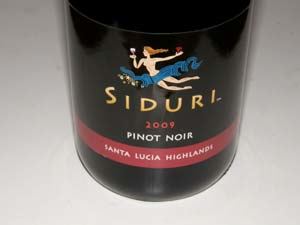 2009 Siduri Santa Lucia Highlands Pinot Noir 14.3% alc., 1,855 cases, $30, screw cap. 45% Rosella’s Vineyard, 26% Pisoni Vineyard, 20% Garys’ Vineyard, and 9% Sierra Mar Vineyard. Clones include Pisoni selection, 777, 828 and Pommard. · The deepest and darkest color in the lineup. Aromas of fresh plums, blackberry jam and a hint of oak. Intense, yet charming essence of black Pinot fruits with a substantial tannic backbone. A seamless and highly enjoyable wine that is clearly representative of Santa Lucia Highlands terroir. Very good.
2009 Siduri Sonoma Coast Pinot Noir 14.1% alc., 1,028 cases, $30, screw cap. · Exotic, demure aromas of berry compote and bacon. Moderately intense flavors of juicy dark berries and plums with a hi-tone backbone fueled by lively acidity. A lot to like here with plenty of tasty fruit, gossamer tannins and a refreshing finish. Good (+).
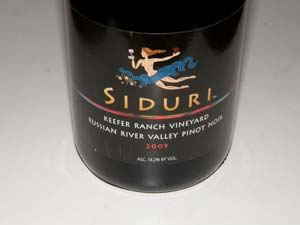 2009 Siduri Keefer Ranch Vineyard Russian River Valley Pinot Noir 14.2% alc., 247 cases, $48. · Subdued but alluring perfume of strawberries, red cherries, cream soda and dried rose petals. Delicious and vivid cherry and berry flavors with hints of baking spice and oak. A hi-collared wine with a lovely mouthfeel, comforting finesse, and a bright pop of cherry on the finish. This vineyard continues to impress.
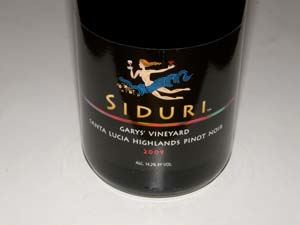 2009 Siduri Garys’ Vineyard Santa Lucia Highlands Pinot Noir 14.2% alc., 298 cases, $50. Siduri is entering the second decade of working with this vineyard. A combination of Pisoni selection on 5C rootstock (33% whole cluster, indigenous fermentation), and Pisoni selection on 3309 rootstock (15% whole cluster, inoculated with a Williams Selyem winery yeast isolate). · Enticing aromas of black cherries, deeply colored berries and cola. A lip smacker with oodles of fruit that saturates the palate and persists on the finish with a clinging vengeance. Soft and smoothly textured, this is a kick-ass Pinot that will bring you to your knees.
Siduri Wines are sold primarily through a mailing list at www.siduri.com, but many larger production wines are in retail and restaurant distribution. An informative newsletter is sent out monthly. The wines are released throughout the year. A personal tasting experience is offered at the winery by appointment, 10:00 AM to 3:00 PM, seven days a week. Phone 707-578-3882 or e-mail at vino@siduri.com. In 2010, Siduri was named “Sonoma County’s Best Winery” by the San Francisco Chronicle online poll.
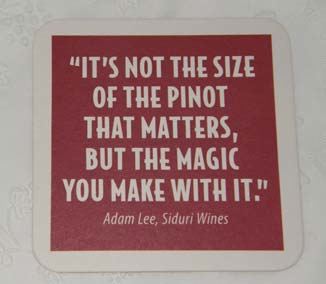
Samsara: Little Known Gem with an Emphasis on Whole Cluster
 Most pinotphiles are very familiar with Melville Winery, but Chad and Mary Melville have a small side project called Samsara, a Sanskrit word meaning the eternal cycle of life. The couple produce small lots (typically 75 to 100 cases) of Pinot Noir and Syrah from carefully selected vineyards in the Santa Rita Hills. Whole cluster fermentation is featured since the Melvilles feel that whole clusters lend a spiciness and complexity to the wines they craft. All Samsara grapes are purchased by the acre and the Melvilles have a strong voice in how the vines from which they source grapes are managed. Their emphasis is on winegrowing, and they proclaim on their site, “We grow wine, we don’t make it.” Winemaking is as follows. A cold soak of 8 to 13 days is followed by native yeast fermentation and 3 to 7 day extended maceration following fermentation. The juice is hand-bucketed into French oak barrels following a gentle pressing and is aged for 18 months (Pinot Noir) to 24 months (Syrah). Native malolactic fermentation occurs at its own pace and the wines are racked once, just before bottling, and neither fined or filtered. I recently sampled three 2008 Samsara vineyard-designate Pinot Noirs from the Santa Rita Hills. These are modern, intensely flavored, fruit-driven California-styled Pinot Noirs, well-crafted, and with a twist created by the significant whole cluster inclusion. Samsara wines are sold primarily through a priority release list at www.samsarawine.com. Guaranteed allocation is offered for each new Samsara wine and the wines are shipped free before public release. Visit the website at www.samsarawine.com. A 2009 Sta. Rita Hills appellation bottling ($30) is also currently offered.
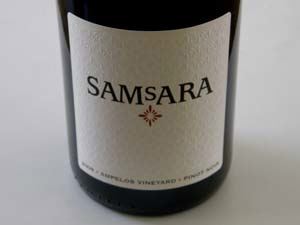 2008 Samsara Ampelos Vineyard Sta. Rita Hills Pinot Noir 14.6% alc., 123 cases, $42. From a biodynamically farmed site. · Moderate reddish-purple color in the glass. Beautifully nuanced aromas and flavors, strapping and hearty but more reserved than the other two 2008 Samsara bottlings. It offers black raspberries, creamy strawberries, cinnamon and ginger flavors with an earthy undertone, holding on tightly on the dramatic finish. Keeps getting better and better in the glass over time. A delicious, supple, tannin-filled wine with personality. I drank this with roast duck and it was a match to die for.
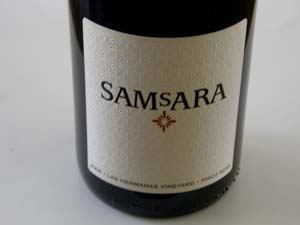 2008 Samsara La Hermanas Vineyard Sta. Rita Hills Pinot Noir 14.4% alc., 108 cases, $44. · The darkest of the three Samsara Pinot Noirs tasted. More subdued on the nose but picking up interest in the glass over time revealing aromas of dark stone fruits, spice, oak, and dark roses. Delicious and vivid plum and blackberry flavors with an underpinning of dark chocolate and vanillin. Only in California can you get high-spirited fruit like this. Drink this with a big ribeye steak. Very good.
2008 Samsara Turner Vineyard Sta. Rita Hills Pinot Noir 14.7% alc., 96 cases, $46. Unfined and unfiltered. · Moderate reddish-purple color in the glass. Welcoming aromas of black cherries, berry jam, purple rose petals and a hint of spice. Tasty core of dark red Pinot fruits with a subtle stem note and a slight confected accent. Nicely balanced with fine-grain tannins and a silky mouthfeel and some persistence of fruit aromas on the finish. A solid wine, but offering a monotone of fruit flavor. Good (+).
george pinot: one man show“One-man show” is usually used as a descriptor for a comedian standing on stage and entertaining an audience. George Levkoff, owner, grape sorter, winemaker, bottler, labeler, marketer, deliverer, and front man for george pinot (George likes lower case - visit www.georgewine.com), is truly a one-man show, and a bit of a comedic and lovable figure as well. George always stands out from the crowd because he never, never, ever wears long pants regardless of the weather or the event he is attending. I don’t think he even owns a pair of long pants, despite spending a good part of his working day in a frigid winery. If you are visiting Healdsburg in frigid January, bundled up to fight off the cold, and you see a guy walking the square in short pants, it will almost certainly be George.
 George is a refugee from the bond trading market who had a wine epiphany when a friend brought a couple bottles of Williams Selyem Rochioli Vineyard Pinot Noir to share with him at dinner. Shortly thereafter, he trashed all his long pants and ties, and headed to Sonoma County intent on making wine. He showed up one day at Williams Selyem and was received by Burt Williams’ daughter Margi. He tried to buy some Pinot, but was told that since he was not on the “list,” he could not acquire any. Margi offered him some swag - hats, shirts with the Williams Selyem logo. George was not easily discouraged and inveigled his way into an internship at Williams Selyem which lasted from 1999 to 2002. He also worked at the smaller Brogan Cellars nearby. With grapes from David Hirsch of Sonoma Coast’s famed Hirsch Vineyard, he released 150 cases of his inaugural Pinot Noir in 2003. The wines were fashioned exactly in the Burt Williams mold using yeasts from Williams Selyem and only Francois Frères as cooper. His wines immediately caught the attention of top sommeliers at restaurants in Las Vegas and New York who were enamored by their elegance and food friendliness. George Pinot quickly became a cult wine. Insiders say that some well-known movie stars will only drink george pinot when they dine out. I have been a fan of george pinot from the beginning, entranced by the finesse and sensuality that his wines exhibit. I have reported on practically every release among the previous six vintages in the PinotFile. His winemaking regimen is not particularly unique. He de-stems 100% of the grapes after careful sorting, cold soaks them a few days, uses Williams Selyem Jackass Vineyard Zinfandel yeast for inoculation, bottles only free-run juice (except in the Sonoma Coma bottlings), and ages the wines in 100% new Francois Frères French oak barrels. The wines are bottled without fining or filtration and hand-numbered. In recent years, George has vinfied small lots of multiple vineyard designated Pinot Noir from the Russian River Valley and a blend labeled Sonoma Coma. If you have spent any time in Healdsburg and were looking for some nightlife, you will understand the humor behind the name, Sonoma Coma. George owns no vineyards and crafts his wines at Moshin Winery on Westside Road. Total annual production is less than 1,000 cases. Join the mailing list to acquire the wines. A listing of notable restaurants that carry george pinot is on the website (Prime, The Four Seasons, Michael Mina, Cut, Delmonicos, Charlie Trotter’s and Dry Creek Kitchen to name a few). The current vintage (Vintage VII, 2009) is sold out, but get on the mailing list for next year. Besides the wines reviewed below, a Sonoma Coma blend is offered, composed of fruit from the five Russian River Valley vineyards that supply fruit to george wine company (280 cases, $600 a case).
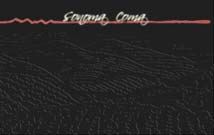
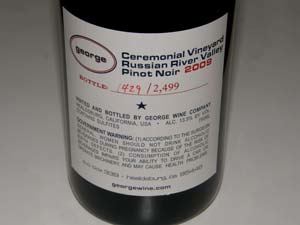 2009 george Vintage VII Ceremonial Vineyard Russian River Valley Pinot Noir 13.5% alc., 208 cases, $700 a case. Farmed by the Martinelli family. · Effusive aromas of blackberries, plums, mocha and oak spice. Luscious and full-flavored, classy and polished, with a long, generous finish. Elegantly crafted exhibiting finesse over fruit heaviness, with charming flavors of dark stone fruits, ripe berries and plum reduction sauce accented by a hint of peppery spice and game. Each sip leaves you begging for more.
2009 george Vintage VII Hansen Vineyard Russian River Valley Pinot Noir 14.4% alc., 185 cases, $700 a case. George says this vineyard is influenced by the adjacent dairy farm and is a favorite on the East coast and among French sommeliers who treasure the smell of fumier. · The nose lacks fruit, offering aromas of oak cask, aged wood, barnyard and wet earth. On the palate, the savory dark red fruit flavors are subdued with an underpinning of tar, earth, and bright hi-tone acidity. Decent.
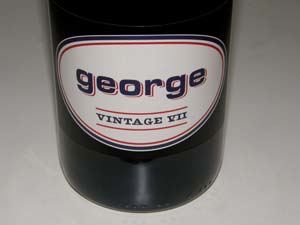 2009 george Vintage VII Leras Family Vineyard Russian River Valley Pinot Noir 13.2% alc., 185 cases, $700 a case. · Muted, but very pleasing scents of exotically spiced berries and black cherries. The flavor profile follows in step with a persistent, grippy finish that is memorable. Flat-out delicious with a fresh and lively texture on the palate. Grand Cru quality.
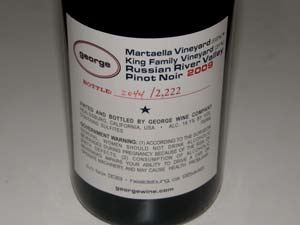 2009 george Vintage VII Martaella Vineyard and King Family Vineyard Russian River Valley Pinot Noir 14.1% alc., 185 cases, $700 a case. Pommard clone. · Moderately deep reddish-purple color. Highly perfumed with an array of fresh berries, fresh and dried rose petals and spice. Flavors of wild berry soup that are crisp, juicy and viscous, coating every nook and cranny in the mouth. Supple tannins enrobe the vibrant fruit which unfurls in waves on the finish. A knockout.
Et Fille: Pretty in PinkPink has become the popular signature of the new “girlie girl” culture, but rarely appears on the labels of serious wines, being confined to rosés, Champagne, and gimmicky wines like Hello Kitty. The pink labels on Et Fille wines, however, are very stylish, and make sense given the father-daughter collaboration that forms the foundation of this winery. I happen to find the labels to be very classy.
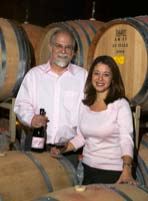 The Mozeico family is quietly turning out some of Oregon’s finest Pinot Noirs. Father Howard, whose background is in software, has been making Pinot Noir since 1984. Daughter Jessica first assisted him with his winemaking efforts in 2000 and the name Et Fille was hatched. “Et Fille” (“ A Fee”) means “and daughter” in French. Howard jokes, “Mozeico et Fille” just wouldn’t work. It made sense to design a pink-themed label, since the winery incorporated a daughter into the team. The goal at Et Fille is to craft small lots of distinctive single-vineyard Pinot Noir in a style suited to the character of each individual vineyard’s terroir. No attempt is made to produce every vineyard-designated Pinot Noir in the same fashion. Father and daughter feel strongly that each vineyard has a unique voice, and they wish to preserve this precious expression of terroir in their artisan Pinot Noirs. A superb Willamette Valley blend Pinot Noir is produced as well and is one of Oregon’s finest each year. The wines reviewed below were made to seduce with harmony and silky textures. All the wines are well-crafted with intense flavors at relatively low alcohols and offer well-balanced acidity. Choosing one as a favorite is really a matter of personal taste. Except for the Willamette Valley blend, all the wines will benefit from further cellaring. The prices are very reasonable considering the quality. These are not girlie-girl wines! Et Fille wines are produced at August Cellars, a state-of-the-art gravity flow winery in Sherwood, Oregon, that is shared by several small wineries. A tasting room here offers some of the Et Fille Wines but an appointment is needed for an extensive tasting (503-449-5030). The wines are sold through a mailing list and are available for purchase on the website (www.etfille.com). Magnums are available.
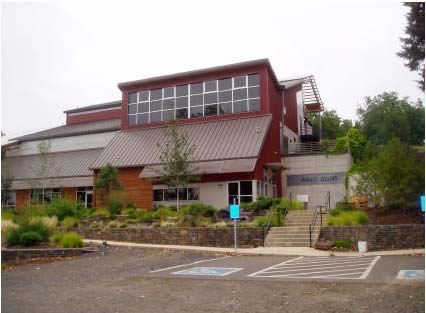
2009 Et Fille Kalita Vineyard Yamhill-Carlton District Willamette Valley Pinot Noir 14.3% alc., 220 cases, $38. Aged 10 months in 33% new French oak barrels. · Subdued, primary aromas of spice, violets, cut flowers and mint. Some very alluring dark red cherry and berry fruit peeks out showing impressive grip, focus and length. Still helter-skelter with fine-grain tannins to the front. All silk and satin on the palate. Like a new Louis Vuitton purse: you need to break it in before showing it off. Will come around sooner than the 2008s, but needs another year or two. Excellent the next day from a previously opened and re-corked bottle. Very good.
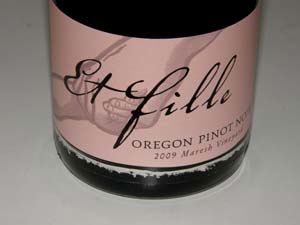 2009 Et Fille Maresh Vineyard Dundee Hills Willamette Valley Pinot Noir 13.8% alc., 103 cases, $42. Pommard clone. Aged 10 months in French oak barrels. · Moderately light reddish-purple hue in the glass. Demure, but pleasing perfume of red and black berries, with hints of smoky oak and tobacco. A young, but sophisticated wine, with a stunning array of black cherry, red currant, and red plum flavors robed in immature tannins. The pedigree of the fruit is obvious. Still showing some unintegrated oak. A powerhouse that is impenetrable and not ready for prime time. Like a new pair of Christian Louboutin shoes: able to attract plenty of attention.
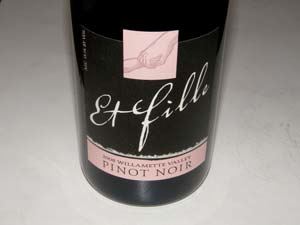 2008 Et Fille Willamette Valley Pinot Noir 13.1% alc., 931 cases, $24. A blend of seven vineyards. · This wine has really blossomed since I tasted it last year. Demure red and black berry medley on the nose echoed on the palate. Medium-bodied and discreetly lush, the dark red berry flavors are wrapped in gossamer tannins and set off by bright acidity. The texture is particularly alluring: all silk and satin. Drinking perfectly now and one of the best 2008 Willamette Valley blends you will find in the marketplace. Very good.
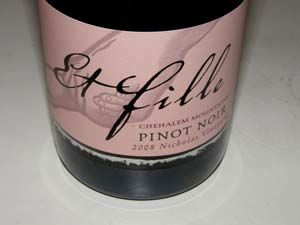 2008 Et Fille Nicholas Vineyard Chehalem Mountains Willamette Valley Pinot Noir 13.7% alc., 172 cases, $34. From the well-known Nicholas Vineyard farmed by Nick and Sheila Nicholas. Pommard clone. Aged 10 months in 31% new French oak barrels. · Moderate reddish-purple color in the glass. Beefy, husky and dark-fruited on the nose. Thick, broad flavors of blueberries, black cherries, black raspberries and dark plums. Tremendous concentration and grip, but retains an attractive feminine tone. Perfectly balanced with a soft but ruffled texture in a worn leather jacket sort of way. Impressive finishing persistence. Even better two days later from a previously opened and re-corked bottle, indicating this wine will be an ideal cellar candidate. Everything you want and some things you didn’t think to ask for in an Oregon Pinot at the right price.
2008 Et Fille Kalita Vineyard Yamhill-Carlton District Willamette Valley Pinot Noir 13.3% alc., $38. Pommard and Wädenswil clones. · The nose is currently closed for business but the flavors say Wow! Mouth coating core of strawberry and black cherry fruit makes you sit up to attention, keeping you interested through the soft, intensely fruity and refreshing finish. Showing very little leg now, and only hinting at its future greatness. Note: some of the Oregon 2008 Pinots are closing up now and this is a perfect example. Cellar this wine for a few years and then enjoy over the next five to ten years. Very good (+).
2008 Et Fille Deux Vert Vineyard Yamhill-Carlton District Willamette Valley Pinot Noir 13.0% alc., 149 cases, $42. Inaugural single-vineyard Pinot Noir from this site. The vineyard is owned by Mike and Patty Green. Wädenswil, 113 and 114. Aged 10 months in 33% new French oak barrels. · A distinctive wine that reflects its Yamhill-Carlton roots. The nose is a challenge to describe but a pleasure to experience with aromas of exotically spiced stone fruits, fig, fruit bin and a hint of pine. Intensely flavored and big-boned dark fruit with undertones of earth and cola, yet silky and light on its feet with a huge, supple finish. Generous tannins should soften over time, but this will always be a tannic wine. Pair with protein like some rare prime rib. This wine is like a tatted biker girl: rugged but very appealing in black leather. Cellar this one. Very good.
Mining for Good Under-$30 Pinot: Inflation TamersIt used to be said that finding good, cheap Pinot Noir was an oxymoron. Not anymore. Allen Meadows has been quoted as saying, “It is a sad fact that inexpensive, high-quality Pinot Noir is almost non existent.” I agree that high-quality Pinot Noir is never a bargain, but today there are many bottlings from California and Oregon that offer good to even very good quality Pinot Noir perfectly suitable for everyday drinking. Many people, particularly the Millenials (ages 21 to 34) and Generation X (ages 35 to 46), are looking for good wines that are affordable and are currently driving wine market growth. The over-47 wine drinkers make up the largest proportion of daily wine drinkers and purchase much of the high-end Pinot Noir, but the wine consumption in this group has changed little over the past several years. The San Francisco Business Times recently reported (www.bizjournals.com/sanfrancisco/news/2011/02/07/theother-guys-wine-sales-soar-66.html) that The Other Guys, which is a separate company under the family umbrella of the Don Sebastiani Family of Companies, had an astonishing 66 percent increase in sales over the last year to 169,000 cases. This surge in sales was led by several brands including Leese-Fitch, Hey Mambo, Plungerhead, The White Knight, MooBuzz, and Pennywise. The company predicted that sales will increase another 50 percent in 2011 to 250,000 cases. The wines are priced in the $8 to $14 per bottle range and offer eye-catching names, labels and alternate closures, all features attractive to the Millenials and Generation X. The MooBuzz and Pennywise Pinot Noirs are reviewed below and offer solid value. Tim Fish, writing in his blog, Exploring Wine with Tim Fish (www.winespectator.com/blogs/show/id/444), wrote an article recently titled, “What Does It Take to Make an $8 Wine.” He notes that the market is flooded with available bulk wine and companies like Don Sebastiani & Sons buy producer’s excess wine at a steep discount and bottle it under their own label. Often the purchased bulk wine is blended with wine produced from existing grape contracts. Winemakers may employ shortcuts like oak staves instead of barrels and micro-oxygenation, both of which can simulate oak-barrel aging.
Micro-oxygenation is a controlled and extended introduction of small amounts of oxygen into wine, developed in the early 1990s by winemaker Patrick Ducorneau, who worked with the highly tannic grape Tannat in Madiran. Ducournau started a company, Oenodev, which offers the technology worldwide. Vinovation in California is Oenodev's representative in the United States. During oak barrel aging of wine, the wood allows a gentle and slow aeration of wine contained therein. Tannins are polymerized into forms that are softer on the palate. The process of micro-oxygenation mimics the effects of barrel aging in wines that are kept in stainless steel tanks. Oxygen is released from a ceramic device placed at the bottom of the fermentation tank. Oxygenation is achieved in a shorter time, and when combined with oak chips or staves to add wood flavor, a significant cost savings results compared to the use of oak barrels. In addition, micro-oxygenation can remove green characters and sulfides from red wines. Jamie Goode in The Science of Wine (2005) notes, “Although micro-oxygenation is quite a new technique, the enthusiasm with which winemakers have adopted it suggests that there must be something to it, even though the exact details of the underlying science aren't actually clear yet.” He quotes Clark Smith of Vinovation as saying, “All the enormous Central Valley producers are currently using micro-oxygenation techniques, and perhaps as many as one-third of the ultra-premium North Coast wineries are at least experimenting with it.” Not all large producers of inexpensive wine resort to these shortcuts. Take Kendall-Jackson, for example. The 2008 and 2009 vintages of their Vintner’s Reserve Pinot Noir (reviewed below) that retail for $18, can frequently be found for a dollar or two less, and offer a very good drinking experience. Tapping into their vast Pinot Noir vineyard holdings, Kendall-Jackson produces a Pinot Noir with a production level of over 50,000 cases that will raise the eyebrows of even the most stodge pinotphile. The Vintner’s Reserve Pinot Noir is aged for 9 months in 15% new, 95% French, oak barrels. The lots, which come from Monterey County, Santa Barbara County and Mendocino County, are kept separate until the final California blend. The recent explosion of second labels offered by premium Pinot Noir producers is a reaction in part to the lucrative market for good, affordable Pinot Noir. Certainly, oak staves and micro-oxygenation are not part of the winemaking regimen for these serious Pinot Noir producers, but they are often shouldered with very drinkable wine that does not fit into their vineyard-designate or appellation bottling program. A good example of this are the $19 2009 Pali Wine Co. Cuvée Pinot Noirs. As owners Tim Perr and Scott knight hand-selected barrels for their single-vineyard bottlings, they found they were left with excess juice. Combined with recession-driven reduced prices for premium grapes, they were able to fashion a more economical tier of wines made with the same commitment to high-quality winemaking that they employ for their single-vineyard Pinot Noirs. The appellation blend Pinot Noirs, each named for a specific neighborhood in the town of Pacific Palisades, California (the hometown of the owners) were launched with the 2007 vintage. Current production of the Cuvée Program is 8,000 cases, with plans to expand to 20,000 cases within the next few years. The wines are vinified by winemaker Aaron Walker under the guidance of consulting winemaker Kenneth Juhasz (Donum Estate, Robert Stemmler, Auteur). The Siduri Sonoma County and appellation bottlings and the Et Fille Willamette Valley Pinot Noir reviewed elsewhere in this issue fit into this category as well. I often am asked, “What is a good affordable Pinot Noir?” Wine drinkers don’t ask for a “great” affordable Pinot Noir, knowing that there is no such thing. Reviewed below are several Pinot Noirs that emphatically answer the question. I have included a few wines that retail over $30 at the winery, but can be found in the marketplace for less than $30. In the under $30 category of Pinot Noir, the economy has forced retailers to lower their prices even further and bargains abound. Check www.vinquire.com, www.winezap.com, www.wineaccess.com, or www.wine-searcher.com for sources. What you get with many under $30 Pinot Noirs: attractive pricing, often discounted; some screw cap closures; light, fruity, food-friendly casual drinking; early drink ability; ease of discovery and purchase due to large production. What you don’t get with many under $30 Pinot Noirs: aromas and flavors that last over time in the glass; age ability; nuance and layering of flavor; purity of flavors unencumbered by oak; the sensuality and sophistication of Pinot Noir. Good and Geek are a few miles apart. You get what you pay for.
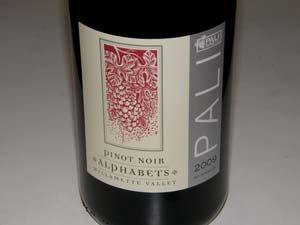 2009 Pali “Alphabets” Willamette Valley Pinot Noir 14.2% alc., 1,030 cases, $19. Aged 10 months in 20% new French oak barrels. · This wine rises above its humble upbringing. Lovely aromas of raspberry jam on brioche with a hint of coffee: breakfast in a Pinot. Very tasty medium weighted flavors of raspberries and cherries with accents of dark chocolate and coffee. Juicy, crisp and refreshing, this smooth player has just enough intense flavor and persistence on the finish to make you sit up and take notice. Very good.
2009 Pali “Bluffs” Russian River Valley Pinot Noir 14.3% alc., 1,229 cases, $19. Aged 10 months in 20% new French oak barrels. · Starts out with a flamboyant perfume of black cherries, sage and coriander seeds but fades over time, becoming less interesting with notes of cherry cola and raisins. Candied cherry flavors with a savory herbal note on the relatively short finish. A smooth operator that seduces more with the flavors than the aromas. Good.
2009 Pali “Riviera” Sonoma Coast Pinot Noir 14.5% alc., 3,576 cases, $19. Aged 10 months in 20% new French oak barrels. · Difficult to coax much aromatic interest out of this wine presently, offering subdued aromas of black cherries, black raspberries and oak. Much more interesting in the mouth, with pleasing red fruit flavors set off by bright acidity. Fruit-driven and highly drinkable. Good.
2008 Kendall-Jackson Vintner’s Reserve California Pinot Noir alc., >50,000 cases, $18. Jackson Estates grown. · Delicate aromas of darker red berries and raisins with a hint of oak. Mildly intense flavors of strawberries, raspberries and cherries with some persistence on the fruit-driven, dry finish. Smooth in the mouth and easy to drink. Will work beautifully at the table when Pinot Noir is called for. Good.
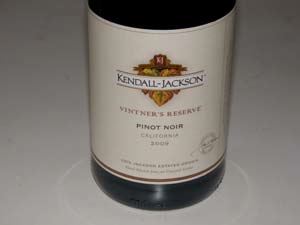 2009 Kendall-Jackson Vintner’s Reserve California Pinot Noir 13.5% alc., >50,000 cases, $18. Jackson Estates grown. · Generous aromas of cherries, raspberries and strawberries with hints of exotic woods. Medium-weight flavors of slightly confected red cherries and berries with the slightest oak vanillin evident. Impressively smooth like Elvis on velvet. I kept sipping over an extended period and the wine kept delivering appealing fruit flavor. All you could ask for at this price: low alcohol, smooth texture, simple but tasty fruit, instant drinkability, ease of acquisition, all from a renowned producer. Good (+).
2009 Meiomi California Pinot Noir 13.9% alc., $18, screw cap. 47% Sonoma County, 19% Monterey County, 34% Santa Barbara County. “May-OH-mee.” Winemaker Joseph J. Wagner of Belle Glos Wines. · Dark reddish-purple hue in the glass. Demure blueberry and plum sauce aromas with distracting oak char. Teeth-staining core of vivid black raspberry, strawberry, plum and cassis flavors with an underpinning of oak toast and vanillin. Blessed with pillowy tannins. This fruit-driven wine will find fans but the oak influence becomes more prominent over time in the glass leading to a jam-on-toast taste. I preferred the 2008 version of this wine, both of which are widely distributed and found on many restaurant wine lists. Decent (+).
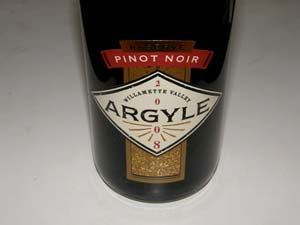 2008 Argyle Reserve Willamette Valley Pinot Noir 14.0% alc., 7,000 cases, $30, screw cap. Winemaker is Rollin Soles. · Moderate color intensity. Appealing aromas of cherries, cola, rose petals and underbrush. Elegant and soft in the mouth, offering discreet flavors of cherries and berries which carry through on the somewhat lengthy finish. A refreshing wine that holds the oak in check and shows some increasing intensity over time in the glass. Good (+).
2009 Brooks Willamette Valley Pinot Noir 14.3% alc., 2,600 cases, $22. 9 vineyard sources. Grapes were 100% de-stemmed and fermented in individual lots. Aged 10 months in 35% new French oak with some Hungarian oak. Unfined and unfiltered. · Moderately light reddish-purple color in the glass. Initially the nose offers demure but satisfying aromas of red cherries and berries, dried rose petals and a hint of baking spice. The aromatic intensity fades over time in the glass with a touch of alcohol rearing up. Medium-weighted red fruit flavors with a nice smack of cherry on the finish. Very soft tannins and a smooth mouth feel make for easy approachability. A fruit-forward wine offering a glimpse of the 2009 vintage in Oregon which offers more upfront charm than the 2008 vintage and higher alcohols. Good.
2008 Patricia Green Cellars Reserve Willamette Valley Pinot Noir 13.0% alc., $29. Blended from wines in the cellar that are a cut above the Oregon designation but don’t fit into a vineyard or special bottling. · Appealing core of dark berries and dark stone fruits with hints of cola and citrus. Plenty of oak overshadows the fruit. Soft in the mouth with brisk acidity. Decent.
2009 Poppy Monterey County Pinot Noir 13.5% alc., $15. · Moderately intense color. Appealing immediately with aromas of black cherries and berries, spice, white pepper and oak and flavors that echo the nose with a subtle underlying grapefruit and woody note. Easy to drink with a decent structural backbone supporting the middleweight fruit, but fades in aromatic and flavor intensity in the glass over time and delivers a shallow finish. Decent.
2009 Wind Gap Gap’s Crown and Griffin’s Lair Vineyards Sonoma Coast Pinot Noir 12.5% alc., 314 cases, $29. From Pax Mahle Wines. Hand-numbered bottles. · Shy scent of black cherries with generous oakdriven aromas of spice, smoke and mocha java. Dark-fruited with plenty of smoky oak, coffee and tar in the background. Somewhat better when re-tasted later in the day with some reduced oak influence but the fruit in this wine still plays second-fiddle to the oak. May show better oak integration with a year or two in the cellar. Decent.
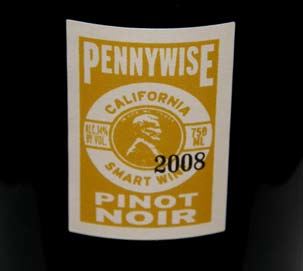 2008 The Other Guys Pennywise California Pinot Noir 14.0% alc., pH 3.81, $10-$13. 94% Pinot Noir, 5% Syrah, 1% Merlot. 70% Monterey (Pinot Noir), 24% Clarksburg (Pinot Noir), 5% River Junction, 1% Paso Robles. Clones are Pommard, 115, 667 and 777. · Interesting depiction of a stamp on the label. Moderately light reddish-purple color in the glass. Aromas of red cherries and berries with a hint of smoky oak. Soft and silky in the mouth with medium-weighted cherry and berry flavors set off by oak-driven brown spices and cola. Some hearty grape variety influence is evident. Reserved tannins and a dry finish. Decent (+).
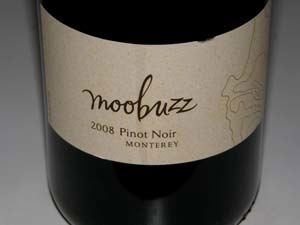 2008 The Other Guys MooBuzz Monterey Pinot Noir 13.9% alc., pH 3.78, $14-$15, bright yellow Zork closure. 95% Pinot Noir, 5% Syrah (for color and richness). 95% Monterey (Pinot Noir), 5% Paso Robles (Syrah). Back label says, “High on a rugged remote central California hilltop, now and then a cow moos to the accompaniment of buzzing bees.” Front label sports a topographical map of Monterey. Very cool package. · Moderately light reddish-purple color in the glass. This wine offers a generous drinking experience with aromas and flavors of cherries and strawberries with mild smoky oak overtones. Very mild tannins, with a refreshing lift of fruit on the finish. Good (+).
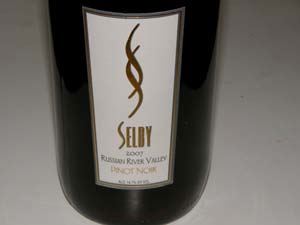 2007 Selby Russian River Valley Pinot Noir 14.7% alc., 579 cases, $27.69, released June 2010. Crafted by Susie Selby. 55% Love Vineyard, 45% Calegari Vineyard. Aged 15 months in 35% new French oak. · Moderately light purple color with a reddish rim. A nicely composed wine with very attractive perfume of Bing cherries, strawberries, baking spices and fresh pastry. Red-fruit-driven with a charming cherry kiss on the lingering finish. Elegant, with enough fruit, acid and tannin to take on the alcohol. Very typical Russian River Valley Pinot Noir. One of my favs at last year’s Pigs & Pinot event. Very good.
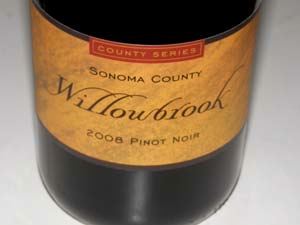 2008 Willowbrook Sonoma County Pinot Noir 14.3% alc., $24, screw cap. Multiple Gold Medals. This winery is really on its game. · A tasty and spirited wine with welcoming aromas of berry pie and black cherry tart. Juicy fruit flavors highlighted by lively acidity and gossamer tannins with subtle oak notes playing in the background. I found this wine for $13 at Bottle Barn in Santa Rosa! Be sure to try the other 2007 and 2008 Willowbrook Pinot Noirs now offered. Good (+).
2009 Enkidu Sonoma Coast Pinot Noir 14.4% alc., 900 cases, $28. · Moderately light reddish-purple color in the glass. The nose is dominated by oak with very little fruit evident. Heavily oak-imbued melange of cherries and berries on the palate. Silky and juicy, but doesn’t deliver much fruit flavor now. May improve with more time the bottle. I have enjoyed other Enkidu Pinots but found this one disappointing. Decent.
2009 Pellegrini Olivet Lane Vineyard Russian River Valley Pinot Noir 13.93% alc., $28. 49% Occidental Road, 33% Burnside Road, 14% BCD and 4% Pierres vineyards. · Bright Bing cherry and fresh strawberry aromas with whiffs of oak and dark chocolate. Discreetly intense red cherry and red berry flavors with a slight confected (Red Vines), earthy, and dark chocolate undertone. Reserved, fine-grain tannins. Well-crafted, but only of moderate flavor interest. Decent (+).
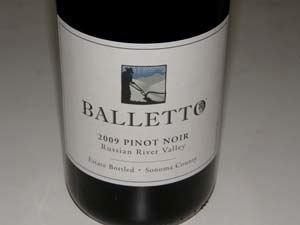 2009 Balletto Russian River Valley Pinot Noir 13.9% alc., pH 3.59, 4,004, $24. Sourced from four vineyards, 16 different lots, 12 different clones. Natural yeast fermentation. Aged in 25% new French oak barrels for 9 months. · Moderately deep reddish-purple color in the glass. Penetrating aromas of blackberry jam with hints of spice, purple roses and oak. Moderately intense core of dark berry and stone fruits with a lasting impression of Hoisin sauce on the finish. Veers to the riper fruit side. Some silky charm with bright acidity. ($16 at Bottle Barn in Santa Rosa). Good (+).
 2008 Trecini Vicini Vineyard Russian River Valley Pinot Noir 13.6% alc., $35. Clones 777 and 828. Frost reduced yields to 3/4 ton per acre. Aged in new and minimally used French Burgundy oak barrels for 11 months. · Opens slowly in the glass to reveal appealing aromas of ripe strawberries, grape must, sandalwood and pine pitch. Discreetly concentrated wave of pretty black cherry and berry fruit underlain with flavors of cola, baking spice and oak, wrapped in mild unresolved tannins and offering a soft mouthfeel. There is an appealing freshness to the fruit here. Typical Russian River Valley offering. I found it at Bottle Barn in Santa Rosa for $24. Good (+).
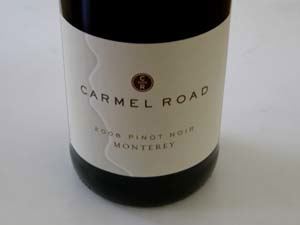 2008 Carmel Road Monterey Pinot Noir 14.0% alc., pH 3.78, $20, released December 2009. Aged 9 months in 98% French (17% new) and 2% American (100% new) oak. · Soft aromas of black cherries, blackberry jam and violets, picking up intensity with swirling. Lightweight flavors of darker Pinot fruits with supple tannins and a velvety mouthfeel. Often discounted and a solid daily drinker. Good (+).
2008 Paradise Ridge Russian River Valley Pinot Noir 13.8% alc., 240 cases, $29. Sourced from 2 vineyards, 4 clones. · Moderately light garnet color in the glass. Subdued scent of strawberries, Bing cherries, and sandalwood. Crisp and elegant in style with understated flavors of red Pinot fruits wrapped in supple tannins. Decent.
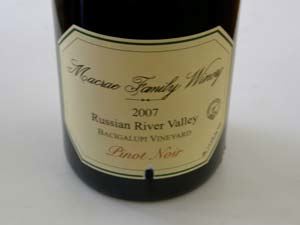 2007 Macrae Family Vineyards Bacigalupi Vineyard Russian River Valley Pinot Noir 14.4% alc., $30. Winemaker Kerry Damskey. · Moderately light reddish-purple hue in the glass. Lovely, complex nose offering aromas of black cherries, mixed berries, rose petals and newly sawn wood. Lighter weighted, crisp and juicy, with ripe stone fruit flavors and a hint of grapefruit peel in the background. Good (+). (Note: check with winery on availability as this was obtained from Bottle Barn in Santa Rosa and is not offered on the winery’s website).
2008 Calstar Sangiacomo Vineyard Sonoma Coast Pinot Noir 15.05% alc., pH 3.42, $35. Aged in 30% new oak (80% French, 20% Hungarian). Winemaker Rick Davis (Londer). · Moderately light in color. Appealing aromas of spiced berry jam on toast which fade some over time in the glass. Tasty essence of red berries with satisfying flavor intensity. Supple tannins, a refreshing grip of acidity and well-integrated alcohol. Good. (Note: I found the wine discounted to $28)
2009 Point Concepcion Salisipuedes Santa Barbara County Pinot Noir 14.7% alc., $25. · Moderately dark reddish-purple color in the glass. An array of medium weight dark berry and plum aromas and flavors elegantly styled with soft tannins. A bit of heat shows up on the entry and finish. Decent.
2008 Babcock Grand Cuvée Sta. Rita Hills Pinot Noir 13.7% alc., $30. · Attractive aromas of black cherries, red currants and strawberries with a touch of spice box. Shallow dark fruit flavors which have a noticeable underpinning of oak. The nose trumps the flavors in this linear wine. Does pick up a bit with time in the glass. Decent.
Mining for Very Good Over-$30 Pinot:Upping the Ante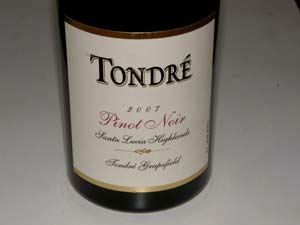 2007 Tondré Tondré Grapefield Santa Lucia Highlands Pinot Noir 14.5% alc., 400 cases, $43. Winemaker Anthony Craig (Sonnet, Muns Vineyard, Silver Mountain Vineyards), grower Joe Tondre Alarid. 60% Pommard, 40% 777. 37% Hungarian oak. 100% de-stemmed. · Seductive aromas of dark berry tart, plum sauce with notes of spice and vanilla. Very tasty essence of black raspberries with a complimentary peppery spice and a hint of mocha java. Very charming with impeccable balance and a silky mouth feel that makes an impression. Quintessential Santa Lucia Highlands at a sensible price (Note: retail price is $43 which is not unreasonable considering the quality, but I found it for $23 at Bottle Barn in Santa Rosa: apparently a close out on this vintage as it was released December 2009).
2008 Lucia Santa Lucia Highlands Pinot Noir 14.1% alc., 550 cases, $40. From Garys’ and Pisoni vineyards, about 50% each. · Deep, dark reddish-purple color in the glass. Ripe and raisiny nose with scents of porto and sassafras. The flavors follow in step in this well-balanced wine that is appealingly soft in the mouth. Decent.
2008 Chehalem Stoller Vineyards Dundee Hills Pinot Noir 13.2% alc., $36, screw cap. · Aromas of dark red cherries and berries, generously oaked. Very demure and reserved red berry flavors which are rather linear. Soft and smooth with a well-proportioned tannic backbone and oak playing a supporting role. Like many 2008 Pinot Noirs from Oregon, this one needs more time in the cellar. Potentially charming. Good.
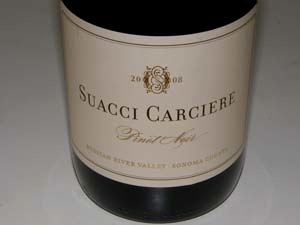 2008 Suacci Carciere Russian River Valley Pinot Noir 13.6% alc., $33. From a 6.5-acre vineyard planted in the especially cool Blucher Valley southwest of Sebastopol. Clones 115 and 777. 100% de-stemmed, indigenous and resident yeast fermentation, aged 11 months in French oak barrels. Winemaker is Ryan Zepaltas (Siduri, Zepaltas). · Moderately light, redder-toned color in the glass. Reduction apparent upon opening and the wine needs some coaxing to emerge. Appealing red berry and cherry flavors, generously spiced, with soft tannins and a welcoming, elegant framework. Considerable more aromatic and flavorful the following day from a previously opened and re-corked bottle. This wine will reward further cellaring. Very good. (Note: the 2007 Suacci Carciere Heintz Vineyard Chardonnay is a stunning wine)
2008 August Truth Split Rock Vineyard Sonoma Coast Pinot Noir 14.3% alc., pH 3.46, $38. Dijon clones. Aged 14 months in oak. Winemaker is Chris Nelson. Deeply colored. · Brooding black fruits which are super ripe with a kiss of oak. Noticeably intense and big-boned array of black raspberry and black plum flavors with a slightly stewed tone, underpinned with notes of earth and oak char. Reserved, slightly grainy tannins with a good acid backbone. Decent.
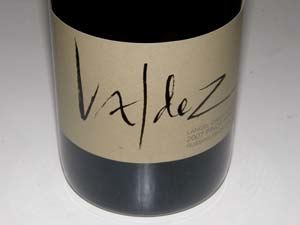 2007 Valdez Lancel Creek Vineyard Russian River Valley Pinot Noir 14.5% alc., $48. · Moderately dark ruby color in the glass. Lovely, spirited nose brightly perfumed with black cherries and boysenberries accented with a floral note. Ripely flavored and muscular in style with prodigious black current, black plum and dark berry flavors wrapped in flamboyant tannins. Needs a big steak. Valdez wines are not bashful or demure, and reflect Ulises Valdez’s gregarious personality. Good (+).
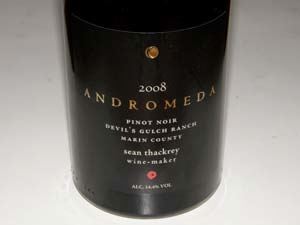 2008 Sean Thackrey Andromeda Devil’s Gulch Vineyard Marin County Pinot Noir 14.4% alc., $45. · Moderately light in color. Unique array of aromas including green garden, cut flowers, and Ponzu. The flavors are unusual and challenging to describe in the manner that I have come to expect from this quirky, talented producer. The wine does not follow the usual hardline flavor profile of Pinot Noir but does offer some tasty black cherry and berry fruit. A leafy, green note runs consistently through the taste profile as well as oakderived vanilla. Soft in the mouth and nicely balanced, this wine was more interesting the next day from a previously opened and re-corked bottle. Could be very interesting a few years down the road. For the adventurous. Good (+). (Note: Sean Thackrey:Wine Maker website is a highly recommended visit if you have any interest in the history of winemaking)
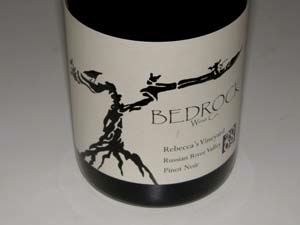 2008 Bedrock Rebecca’s Vineyard Russian River Valley Pinot Noir 14.4% alc., 189 cases, $34 (sold out). From a tiny winery owned by winemaker Morgan Twain-Peterson. Sourced from a 12-year-old vineyard owned by the Hermsmeyer family across the street from Joe Swan Winery and adjacent Kistler’s Vine Hill Vineyard. Native yeast fermentation. Aged in 55% new supertight- grained French oak barrels. Racked once before blending and bottling. · Brooding nose initially, opening slowly to reveal delicate aromas of spiced black cherries and subtle oak notes. Delicious middle to heavy weight core of black cherry and black raspberry fruit with a pouty kiss of cherries that sails smoothly through the long finish. The seductive fruit has a mineral component and is robed in young, healthy tannins. Oak contributes flavors of spice and mocha java. Still young, and deserving of a few years in the cellar to soften the tannins and fully integrate the oak. Great potential here. Very good.
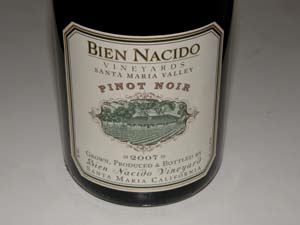 2007 Bien Nacido Vineyards Santa Maria Valley Pinot Noir 14.2% alc., $52. The inaugural bottling under the Bien Nacido Vineyards label. · Deep reddishpurple color in the glass. Ripe black cherry and black raspberry aromas with plenty of smoky, toasted oak. Abundance of very ripe-flavored dark berry, black currant and black plum fruit dragged down by too much smoky oak. Softly textured and easy to approach, with the structure to age. Disappointing at this price especially considering the venerated vineyard source. Decent.
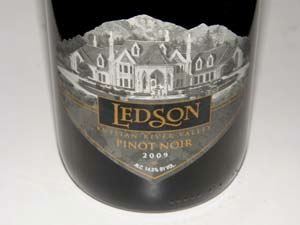 2009 Ledson Russian River Valley Pinot Noir 14.5% alc., pH 3.95, 693 cases, $60. Aged 10 months in65% new French oak barrels. · Very dark reddish-purple color in the glass. Lovely aromas of fresh ripe, crushed strawberries, dried cherries and spice box. Attacks the palate with a load of Pinot extract, offering a plush drinking experience with subtle oak highlights, but lacking in acid backbone. Plenty of velvety flesh on the bones and fruit-lovers will adore this Caliesque wine, but I don’t think it has enough tannin and acid to go the distance and is best consumed young. Good (+).
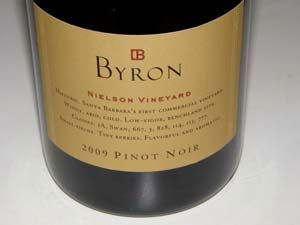 2009 Byron Nielson Vineyard Santa Maria Valley Pinot Noir 14.9% alc., 1,028 cases, $34. From Santa Barbara’s first commercial vineyard, planted in 1964. Clones are 2A, Swan, 667, 828, 114, 115, 777. Small yields and tiny berries from a windy, arid site producing low-vigor. Aged 16 months in 30% new French oak barrels. · Highly aromatic with scents of plum reduction sauce, dark roses, lavender and Santa Maria spice. The flavors of dark plums, purple grapes and dark berries are quite distinctive and zesty, with an impressive aromatic lift of black cherries on the finish. A little earthy, a little spicy, with well-proportioned fine-grain tannins and a pleasingly smooth mouth feel. Drank beautifully the next day from a previously opened and re-corked bottle. Immensely satisfying. (Note: the 2009 Byron Santa Maria Valley bottling at $25 is quite good as well and was reviewed previously)
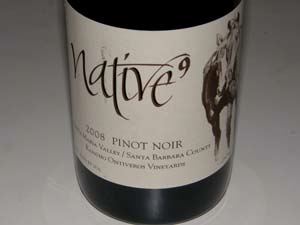 2008 Native9 Rancho Ontiveros Vineyard Santa Maria Valley Pinot Noir 14.5% alc., $60. · Moderately deep reddish-purple color in the glass. Dark cherry and berry perfume with striking Moroccan spice and an underlying green, stemmy note. A medium-bodied mix of cherries and berries taking on more intensity over time in the glass and assuming a savory herbal tone. I suspect the whole cluster fermentation contributes the attractive spice elements to this wine as well as the unattractive green component. Tasted later in the day with dinner, the wine really sang with the food. Tasted the following day from a previously opened and re-corked bottle, the green edge to the aromas and flavors was still evident. Time will tell whether this will change. Good.
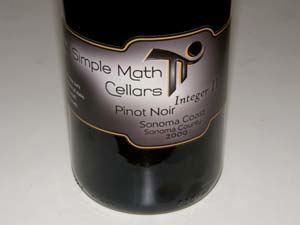 2009 Simple Math Cellars Integer II Sonoma Coast Pinot Noir 14.6% alc., pH 3.93, 70 cases, $35. Sourced from Keller, Rodgers Creek and Sangiacomo vineyards. Aged 19 months in 70% 1-year-old Francois Fréres and Demptos French oak barrels. Pommard, Dijon 115, 667, 777 and 828. · Brooding, initially sporting aromas of dark cherries, earth and peat, later becoming smoky and tarry. Dark red cherry essence with toasted oak and spice in the background. Nicely balanced and very Russian River Valley in character. Good.
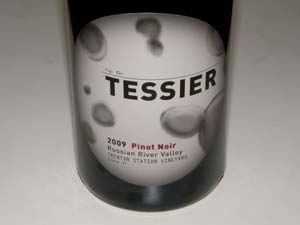 2009 Tessier Trenton Station Vineyard Russian River Valley Pinot Noir 13.8% alc., pH 3.50, 182 cases, $35. Clone 37 (Mt. Eden). Aged in 35% new French oak. Winemaker Kristie Tacey. · Some reduction upon opening, quickly resolving to reveal aromas of red fruits, fading over time becoming muted and nondescript. Red-fruit driven with flavors of cranberries, cherries and raspberries with some earth and savory herbs in the background. Bright acidity with a cherry-toned tangy finish. Light and elegant, offering more flavor interest over time in the glass. A Burgundian-styled Pinot that grows on you. Good.
Campesino CellarsOne of the joys of what I do is discovering small boutique producers of Pinot Noir. I receive inquiries weekly from new producers and some of them pan out, others have not reached the gold ring yet. In January 2010 I received an e-mail from Macario Montoyo asking to submit his Campesino Cellars Pinot Noir for review. I had no clue who he was but his name piqued my interest. I have had a long-standing attraction to stories of the Mexican immigrant fieldworkers and their success in the California wine business. I wrote about their triumphs previously in the PinotFile (www.princeofpinot.com/article/707/). Macario grew up in the small town of Elmira, near Napa Valley. At the University of Notre Dame, his interest in wine was piqued and after working six years in the corporate world as a financial adviser, he gave up his suit and tie for purple hands and pruning shears, returning to his longings to craft wine. Griselda Montoya grew up in the Carneros region of Napa, always surrounded by vineyards and wine. Her brothers and their spouses founded Ceja Vineyards. She is currently a vice president client manager for Bank of America and as a lover of wine, founded Campensino Cellars with Macario. The Campesino label is quite intriguing, featuring the hands of Griselda’s father, Pablo Ceja. They represent the gnarled hands of a man who labored in the vineyards for forty years after immigrating from Mexico in 1967. Macario commissioned his younger brother, Maceo, an accomplished writer and artist, to draw Pablo’s hands for the label.
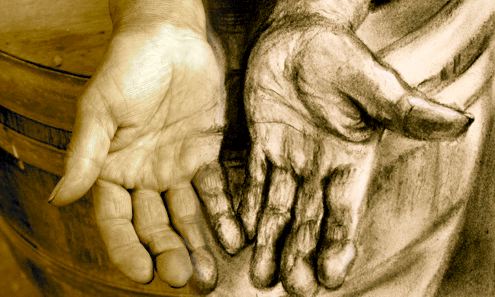
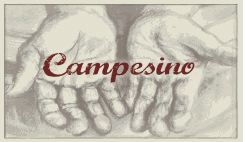 Campesino (“Camp-pe-si-no”) translates in English as fieldworker. The Campesino Cellars wines are a homage to all campesinos. “A mis carnales y mis carnala gracias por su trabajo”: To my brothers and sisters thank you for your work. Campesino Cellars offers a Sonoma Coast Syrah from Sangiacomo Vineyard and a Napa Carneros Pinot Noir from Papi y Chula Vineyard. The Papi y Chula Vineyard is owned and farmed by the Ceja family, The vineyard is the site where Griselda spent her childhood and where she and Macario were married in 2007. The 5-acre vineyard, which is located but a mile from San Pablo Bay, is farmed by Griselda’s brother, Armando Ceja.
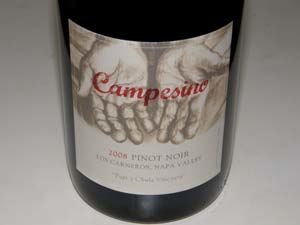 2008 Campesino Cellars Papi y Chula Vineyard Los Carneros Napa Valley Pinot Noir 14.1% alc., 50 cases, $38. Aged 18 months in seasoned French oak barrels. · Moderate violet color in the glass. Highly perfumed with deep aromas of earth-kissed plums, black raspberries, underbrush, oak and cardamom spice. The dark berry and stone fruit flavors are perfectly ripe, delicious and persistent, with appealing accents of grilled mushrooms and faint oak. I thought I could taste the soil in this wine. Beautifully balanced with supple, well-tamed tannins. Hard to imagine how something so grand can come from something as simple as a grape. Quintessential Carneros.
Campesino Cellars wines are available through the winery’s online store at www.campesinocellars.com. Join the mailing list for future releases.
Note about Ceja Vineyards. “Vinum Cantus Amore,” loosely translates to “Wine, Song and Love,” the motto of Ceja Winery. In 1967, Pablo Ceja, his wife Juanita, and their six children said goodbye to friends and family in Mexico and immigrated to the United States as part of the guest worker Brasero Program established after World War II. The entire family worked in the vineyards after their arrival. After many years in that program, Pablo moved to St. Helena and toiled in local wineries. Later, he moved his family to the Carneros region. In 1983, the now extended family pooled their resources and invested in 15 acres of Carneros land. In 1986, 13 acres were planted to Pinot Noir. Ceja Vineyards eventually acquired other land and now farm four large vineyards comprising 113 producing acres. In 1998, Ceja Vineyards, Inc., was founded to produce premium Carneros wines. Today, Ceja produces both a Carneros and Sonoma Coast Pinot Noir, and a sparkling Blanc de Noir and sparkling Brut. A glass of Ceja Pinot Noir is like a drink of history. You can see the land, smell the passion and dedication, and taste the journey. A true American immigrant success story. Visit the website at www.cejavineyards for more information.
Tantara: Thoroughbred PinotsJeff Fink and Bill Cates both hale from Virginia, but met in California and founded Tantara Winery as partner winemakers in 1997. The label prominently features a horse once owned by Bill Cates named Tantara. Ask Jeff to tell you the humorous story behind the horse. After being retired to pasture, the mare defied those who predicted an imminent demise and lived a long life. The horse symbolizes grace and power as well as long life, all qualities that Tantara wines embrace. Tantara produces a broad range of vineyard-designated Pinot Noir, Syrah, Pinot Blanc and Chardonnay from multiple very high-end Central Coast sources and also farms 14 acres at Bien Nacido Vineyards in the Santa Maria Valley (2 acres of Bien Nacido G Block Pinot Noir, 10 acres of other Pinot Noir, and 2 acres of Syrah). Vineyard sources include Bien Nacido, Dierberg, Solomon Hills, Sanford & Benedict, Rio Vista, Lindsay’s, Talley Rincon, La Colline, Silacci, Pisoni, Garys’ and Brousseau. In 2008, Tantara produced a dozen Pinot Noirs and five Chardonnays. The 2008 vintage began with an April frost in some Tantara vineyards, but the growing season was moderate and even. Unlike the 2007 vintage wines that had high levels of tannin and took a lengthy time to show themselves, the 2008 vintage wines have more precocious aromatics and flavors. I recently sampled three of the 2008 Tantara Pinot Noirs. I have tasted a number of Tantara Pinots through the years at dinners and festivals, but never had the opportunity to sit down and seriously taste. I found the wines to be a revelation. All were deeply colored with bold flavors with plenty of Santa Maria Valley soul. The tannins and oak were well managed, the silky textures were very appealing, and the wines were impeccably balanced. These are extremely well-crafted wines that represent the best that Santa Maria Valley has to offer. The winemaking regimen for Pinot Noir at Tantara is as follows. The grapes are de-stemmed with some whole cluster included depending on the vineyard and vintage, and fermented with both native and proprietary yeast in open top vats. Punch down is by traditional methods. Aging is carried out in modest new French oak. The wine is racked after undergoing MLF in barrel and left undisturbed until it is blended and bottled, unfined and unfiltered. Tantara wines are sold primarily through a mailing list and online at www.tantarawinery.com. Tasting at the winery, located at Bien Nacido Vineyards, is available by appointment (805-938-5051). Jeff is a very laid back guy (despite his serious demeanor below) who will charm you with his personality and his wines. Saddle up.
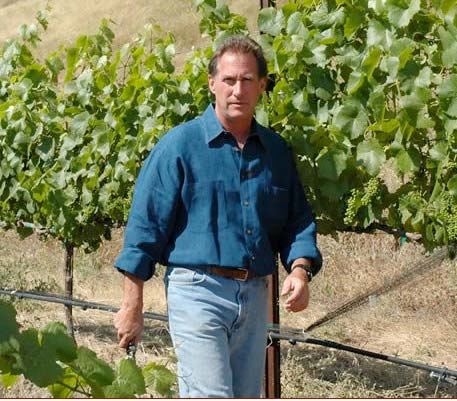
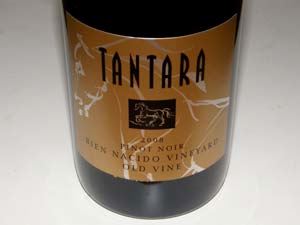 2008 Tantara Bien Nacido Vineyard Old Vine Santa Maria Valley Pinot Noir 14.8% alc., pH 3.50, 167 cases, $48. Own-rooted Pommard 4 clone planted in 1973 (G Block). Average yields 1.9 tons per acre. 80% de-stemmed. Aged 16 months in 30% new French oak. · A spirited nose offers flamboyant aromas of black cherries and spice box including star anise. The wine pumps out the aromas consistently over time in the glass. Tasty core of plum, black cherry and dark berry flavors with an appealing spice and earthy undertone. This wine literally tastes like the earth in which it is grown. Veers slightly to the ripe side but does not cross the line. Moderately rich with a smooth mouth feel, supple tannins, and a clean finish. Bien Nacido Vineyard at its best.
2008 Tantara La Colline Vineyard Arroyo Grande Valley Pinot Noir 14.5% alc., pH 3.40, 383 cases, $48. La Colline is part of Laetitia Vineyard, located four miles inland from the Pacific Ocean at the base of Picacho Peak, an extinct volcano. Own-rooted Martini clone planted in 1981. Average yields 2.1 tons per acre. 80% de-stemmed, 20% whole cluster fermented with native yeast. Aged 16 months in 40% new French oak barrels. · The nose is primary with subdued fruit and aromas of wet leaf, earth and subtle oak. Dark red fruits are discreetly composed with an earthy, grilled mushroom underpinning. Beautifully balanced with supple tannins and juicy acidity. Plenty of charming fruit waiting to get out in this backward wine. Patience will be rewarded. Very good.
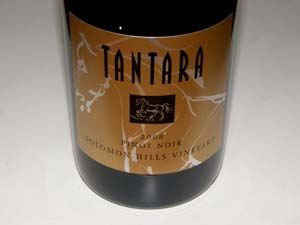 2008 Tantara Solomon Hills Vineyard Santa Maria Valley Pinot Noir 14.5% alc., pH 3.40, 387 cases, $48. From a 97-acre vineyard located 14 miles from the Pacific Ocean with a strong maritime influence. Clones are Dijon 777, 667, 115, 2A, and Pommard 5 planted in 1999. 80% destemmed with 20% whole cluster. Aged 16 months in 30% new French oak barrels. · Opens slowly in the glass, seducing you gradually. Enticing aromas of dark cherries with a hint of dark chocolate and spice. Amazingly persistent on the palate and through the lengthy finish. The flavors of plum and black cherry are intense and vivid, yet the wine retains a charming, silky finesse. Even better the following day from a previously opened and re-corked bottle. Angelina Jolie in dark red velvet.
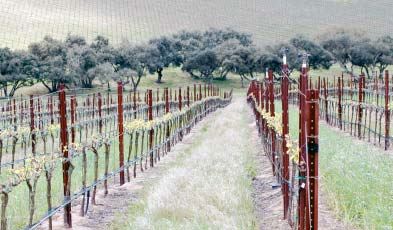
West Sonoma Coast VintnersA group of wineries and vineyards on the western, coastal part of the Sonoma Coast have joined to form the West Sonoma Coast Vintners (WSCV) association. These West County Pinot Noir producers have longed to distinguish themselves from the more inland Sonoma Coast wineries who are in a distinctly different environ. The WSCV vintners are located on the “true” Sonoma Coast, a strip of ridge top vineyards that demonstrate a specific expression of Pinot Noir and Chardonnay. The region includes the growing areas of Annapolis, Fort Ross/Seaview, Occidental, Freestone, Green Valley and Sebastopol Hills. The work of this group may lead to a separate appellation one day, but for now they are content to educate consumers on why wines from West Sonoma Coast are distinctive.
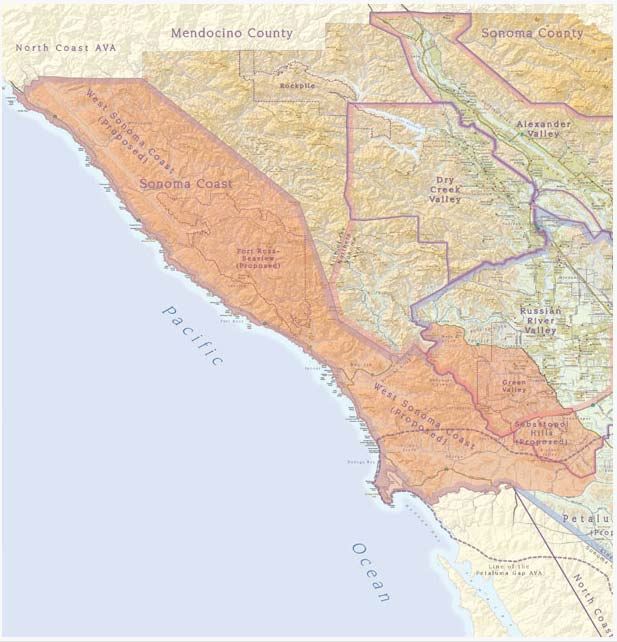 Winery members of WSCV include: Boehme Wines, Chasseur, Failla Wines, Flowers Vineyard & Winery, Freeman Vineyard & Winery, Fort Ross Vineyard & Winery, Freestone Vineyards, Hawk Hill Vineyard, Hirsch Winery, Littorai Wines, Patz & Hall Wine Company, Peay Wines, Ramey Wine Cellars, Red Car Wine Company, and Small Vines Wines.
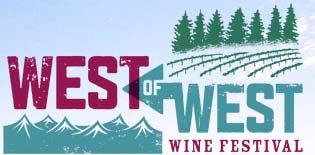 The West Sonoma Coast Vintners will launch a new wine festival in 2011 on August 5-7 called “West of West Wine Festival or W.O.W.” The weekend-long event will be held in Occidental and will feature some of the most highly regarded Pinot Noirs, Chardonnays and Syrahs from West Sonoma County. Welcome dinners will be hosted by member wineries on August 5, Saturday will begin with morning seminars and will be followed by a Grand Tasting, culminating that evening with a Whole Hog Feast at the 130-year-old Union Hotel. Sunday, August 7 will feature barrel tastings and open houses at all participating wineries. Tickets are available now at www.westsonomacoast.com or 1-888-878-9645. Be sure to get tickets for the Ted Lemon/Burt Williams Winemakers Studio on Saturday morning, August 6. I already have my tickets for this extraordinary inaugural event.
My Purple Tongue Days with PETPetite Sirah is celebrating 50 years since Concannon Vineyard’s James Concannon bottled the first varietally labeled Petite Sirah in California in 1961. This brought back memories of my early dalliances with Petite Sirah. My formative years with wine involved many bottles of Mateus, Lancers, Blue Nun and Spanada. After my medical training and stint in the U.S. Air Force, I had enough spendable income to dabble in real wine. I was drawn to Petite Sirah because of its bold, sweet blackberry jam flavors and black pepper spice. It seemed to me the perfect wine to pair with grilled steak and in those days, my cooking repertoire was largely limited to barbecuing steaks. There was one Petite Sirah in particular that caught my attention: Concannon Vineyard. Maybe it was the fact that Concannon was the first California winery to label a wine Petite Sirah, or maybe it was because the winery had some familiar kinship (founder James Concannon was born on St. Patrick’s Day in Ireland). Most likely it was because I liked the taste of the masculine wine and as a young bachelor, identified with its machismo style. The Petite Sirah grape was developed in 1880 by Francois Durif in Montpellier, France by crossing Syrah and Peloursin. Syrah is the noble variety that originated in France’s Northern Rhome and is the basis of the great wines of Hermitage. Peloursin is from a more humble background originating in Southern France. Since cross breeding of grapes is frowned upon in France, Petite Sirah was not accepted there and found a new home in the United States, where along with Zinfandel became America’s own variety. Petite Sirah and Durif are interchangeable synonyms for the same grape.
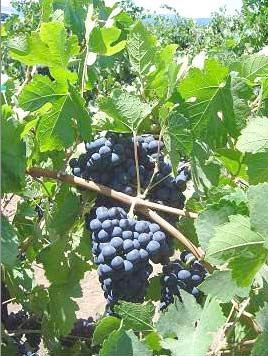 Petite Sirah is sometimes mistakenly spelled Petite Syrah, which historically was the spelling used by Rhone growers to refer to the small berries of some of their Syrah grapevines. Immigrant winegrowers used the phrase Petite Syrah to refer to the lower yields that the Syrah vines were producing in California, and old timers called Petite Sirah “Petty Sarah.” Today, Petite Sirah has taken on the shortened name, “PET.” Current DNA research at the University of Calfornia at Davis indicates that there are at least three diffrerent varieties that go by the name of Petite Sirah but only one is apparently Durif. First planted in California in 1884, Petite Sirah was the blending backbone of many home made Prohibition-era wines. According to the Petite Sirah advocacy group, P.S. I Love You, there were approximately 4,440 acres of Petite Sirah planted in the United States when James Concannon bottled America’s first varietally labelled Petite Sirah. The grape, like James Concannon, has shown plenty of pluck. It survived phylloxera in the 1890s, both World Wars, the Depression and Prohibition. Fifty years later, acreage has nearly doubled, to 7,592 acres, and there are now 723 producers that feature a Petite Sirah in their lineup of wines. Recent Nielsen data shows that Petite Sirah was a popular varietal with consumers in 2010, the second fastest growing red varietal in the industry, narrowly behind Pinot Noir.
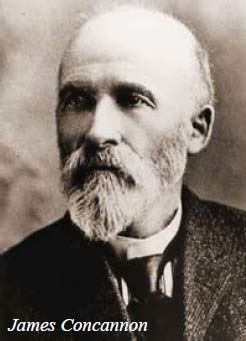 Concannon Vineyard, located in the East Bay in Livermore, California, was the first winery I visited. It was around 1974 when I bought my first case of wine at Concannon, one of life’s rites of passage. Concannon Vineyard is now a member of California’s 100-year-old club and its history is fascinating. Founder James Concannon left Ireland in 1964 at the age of 17. He was an adventurous type who would need all his intelligence, character, grit, and luck to succeed. He landed in Boston, and eventually found a job as a bell boy at a hotel in Augusta, Maine. It was there he met and married an Irish lass, Ellen Rowe. In 1874, Concannon, accompanied by his wife and new baby, traveled in a covered wagon across the country to Oregon. After initially managing a sheep ranch, Concannon moved to San Francisco and made considerable money selling rubber stamps throughout the West Coast. He became a respected businessperson at age 32. His success allowed him to pursue his interest in viticulture. He enrolled in college to learn about grape growing and traveled to France to find good rootstock. In 1883, he planted his first 40 acres in the Livermore Valley, east of San Francisco. The cuttings were from Chateau Y’Quem. A few years later, Concannon became the first Irish immigrant to make wine in America. When Prohibition came into effect, Concannon was one of the few wineries that legally stayed in business because Petite Sirah was a main ingredient in sacramental wines. The Concannon Vineyard has passed through a few hands (first Wente, most recently The Wine Group), but direct descendant and fourth generation vintner John Concannon is active at the winery. Petite Sirah has remained the flagship wine for Concannon Winery. A public two-day celebration of Concannon’s historic Livermore Valley winery is planned for August 13-14, 2011, and will include vertical tastings from Concannon’s library. John Concannon will host retrospective tastings of Petite Sirah in over 50 markets across the nation in 2011. John Concannon is a founding member of P.S. I Love You and hosts the wine industry’s annual national symposium for growers and wine producers to share vineyard and production practices. This year’s event will be held July 26, and will feature live-streaming online to allow consumers to ask questions directly to some of the most notable vintners and growers in the Petite Sirah community. The flavor profile of Petite Sirah is similar to Syrah but the wine is not as elegant. Typically, Petite Sirah is darkly colored, inky and tannic, with a peppery note, and can very extremely long-lived. I have a soft spot for Petite Sirah and occasionally pop the cork on a bottle from Concannon or Foppiano or any one of the other many producers of Petite Sirah in California. Of course, the barbecue is always lit at the same time.
Pinot Briefs
 Domaine Serene Rosé Domaine Serene has released a serious, dry Provence style rosé that is barrel-aged. Labeled “r” but introduced as “R,” in an alluring bottle design, this rosé is sourced from the Williamette Valley (50%), Walla Walla (10%) and Rogue Valley (40%). It is bottle-aged (55%, 10% new) in French oak in the same manner as a Rosé de Provence. M. Eleni Papadakis is the winemaker. $35/btl. Order at 866-864-6555 or by e-mail at info@domaineserene.com. When Irish Wines are Smiling 2011 Sunday, March 13, 2:00-5:00, Rutherford Grange Hall, 8550 St. Helena Hwy, Rutherford, CA. Second annual celebration of Irish involvement in wine and food. Wineries participating include Flora Springs, Harrington Wines, Murphy Vineyards, Dillon Vineyards, Twomey Cellars, and Waits-Mast Family Cellars. Hurley’s Restaurant will provide the food. Live traditional Iris music and dancing. Tickets are $35 in advance: www.whenirishwinesaresmiling2011.eventbrite.com/.
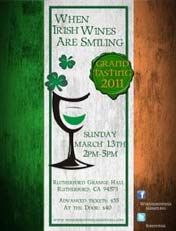 St. Mark’s 2nd Annual Cellar Classic: Auction of Rare & Fine Wines St. Mark’s-in-the- Valley Episcopal Church is hosting this event on Saturday, July 30, 2011, in the Church’s garden courtyard in Los Olivos. The Cellar Classic is coordinated by a group of dedicated wine industry volunteers led by Brooks Firestone (owner of Curtis Winery), Richard Harris (owner of Calzada Ridge), and Steve Pepe (owner of Clos Pepe Vineyards). Both a live and silent auction will benefit the many community programs of the Church. Wine journalist Gabe Saglie named St. Mark’s Cellar Classic one of the top ten not-to-miss wine events in 2011 and noted that the 2010 event “gave the fancy Napa Auction a real run for its money.” Donated wines include a 1947 Chateau Cheval Blanc, a 1949 Leroy Musigny, and a double magnum of 1989 Diamond Creek Volcanic Hill. Tickets are $100 per person in advance only. Contact Steve Pepe at steve@clospepe.com or call 805-735-7867.
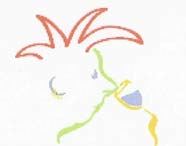 IPNC Video Debuts Jay Selman of Grape Radio, videographers Andrea Johnson and Robert Holmes, and myself, created a short video on the International Pinot Noir Celebration. We are very proud of it. Check it out at www.ipnc.org/multimedia.php. This summer (July 29-31, 2011), the 25th International Pinot Noir Celebration will be held in McMinnville, Oregon. Many of the winemakers chefs, and media who attended the inaugural event 25 years ago will be reunited including some of Oregon’s Pinot Noir pioneers. This will be a memorable event and I would encourage you to attend, especially if you have never been to this oldest North American Pinot Noir Festival. For tickets: www.ipnc.org. Peter Michael Debuts New Pinot Noirs In the fall of 2011, Peter Michael will release their first Estate Pinot Noirs from the Seaview Vineyard on the Sonoma Coast: 2009 Le Caprice Estate Pinot Noir, 2009 Ma Danseuse Estate Pinot Noir, and 2009 Clos Du Ciel Estate Pinot Noir. The 400-acre site, bought in 1998, is located at 1,000 to 1,500 feet above sea level in the Fort Ross-Seaview region of the true Sonoma Coast. Planting of 30 acres of selected Burgundian field selection Pinot Noir started in 2006. The winemaker is Nicolas Mortet. Peter Michael has produced Le Moulin Rouge for several years, a Pinot Noir from the famed Pisoni Vineyard in the Santa Lucia Highlands. Peter Michael wines are sold exclusively through a currently full mailing list (6 to 18 months waiting period to be offered wine) at www.petermichael.com. Cochon 555 So you couldn’t get tickets to this year’s Pigs & Pinot event in Healdsburg? Check out the third US tour of Cochon 555 featuring five chefs, five pigs, and five wines. Events to come in Napa, Washington D.C., Chicago, Denver, Los Angeles, New Orleans and San Francisco. A unique culinary competition and wine tasting event to promote sustainable farming of heritage breed pigs. Each city stop offers local farmers the opportunity to connect with renowned chefs and the pork-loving public. Cochon 555 is the only heritage breed pig culinary competition in the country. View trailer at www.cochon555.com/2011/ trailPop.html. Tickets and more information at www.cochon555.com.
 PNizzle: A Pinot Noir Tasting Soirée Green Jug Fine Wine & Spirits is hosting its inaugural Pinot Noir extravaganza featuring 36 wines from 22 boutique wineries specializing in Pinot Noir from California and Oregon. The event will be held March 5 at Morton’s Steakhouse in Woodland Hills, CA. Wineries include Bergström, Capiaux, Dierberg, Erath, Flowers, Goldeneye, Ken Brown La Follette, LIOCO, Martinelli, Moshin, Patz & Hall, Penner Ash, Sojourn and Woodenhead. Tickets are $60 including gourmet food bites. Visit www.greenjug.com/shopexd.asp?id=20294. Check out Byron Vineyard & Winery Sure, this large producer has been around a long time, maybe it has been overlooked by those looking for the next great cult producer of Pinot Noir. Quality at this Santa Maria Valley producer has never been greater. Winemaker Jonathan Nagy has been receiving well-deserved press of late for his wines. I recently reviewed the 2009 Byron Santa Barbara County Pinot Noir ($17) and the 2009 Byron Nielsen Vineyard Pinot Noir ($34). These are exceptional wines priced right. A new tasting room is open daily from 11:00 to 5:00 at 2367 Alamo Pintado Avenue in Los Olivos. 888-938-7310. Dutton-Goldfield Pruning Tutorial Dutton-Goldfield sends out a frequent internet newsletter that is very informative. Recently the newsletter spoke of the Dutton Ranch crew making progress with pruning. The pictures below were provided that show how the various styles of vineyards and trellising are pruned. Below left is a Cordon pruned vine, before and after pruning, and below right a Cane prune vine, before and after. For the Unilateral Cordon pruned vine, two buds are left on each of about 12 spurs, and each spur is about 4-5 inches apart on the cordon (arm). The Cane pruned vine is pruned back to two new canes that will provide the fruiting wood for this year. Visit www.duttongoldfield.com to sign up for the newsletter. The Pinots are great here!
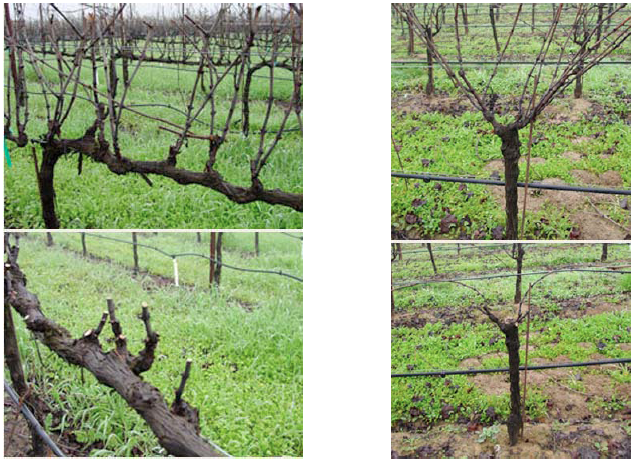
Aging Pinot Noir: Not An Exact Science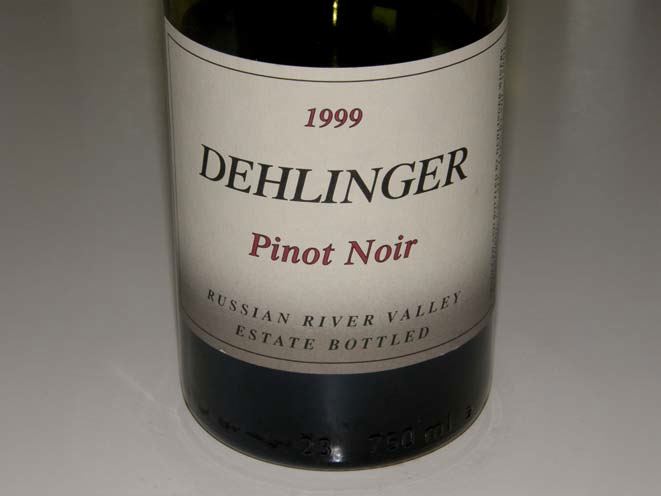 One of my wine buddies used to say about any wine that was less than five years old, “It’s not ready to drink. It’s a baby, a Lolita.” Sometimes I wondered if he ever enjoyed a bottle of wine, since he felt that any opened wine would have been better with more age. Judgments about when wine will reach it’s peak are very subjective. For me, I don’t want to worry about how long to cellar a wine. I just pop the cork when I feel like drinking it. I happen to like wine when it is fresh and flush with plenty of fruit, but I can appreciate an older wine at its zenith. Winemaking techniques in North American today favor fruitiness, freshness and approachability upon release, not extraction of tannins needed for a wine to age. That said, a quality wine crafted with balance has a good chance of improving in the bottle and aging admirably. For domestic Pinot Noir, probably less than 20% of wines produced will benefit from more than three years of cellaring. Only quality wines will become more interesting over time in the bottle. Cellaring a bad bottle of wine for five years will not turn it into a better wine. It has been suggested that persistence can predict age ability. Count the number of seconds a wine’s aroma lasts on your palate once you spit or swallow the wine. If it lasts longer than 6 seconds, the aging potential is good. More than 8 seconds, and the wine will likely last a number of years in the cellar. Another gauge of age ability is the taste of a wine that has been opened and re-corked one, two, three days after opening. A wine that improves after opening will often benefit and even shine with further time in the bottle. Cellaring wine undisturbed at the correct temperature (about 55ºF) is essential for longevity. Magnums offer a significantly increased chance of preservation and improvement in the cellar. The golden rule of aging wine is to never let it slip past its prime. When a wine is dead, it will never come back to life. Decrepitude is fatal. When you discover a wine that is at it’s peak, pull the cork on every bottle you own, invite me over, and let’s party. |